Today we will consider a representative of the popular “P” line, the best 32 inch monitor, which can be classified as a mid-range segment. The Dell P3222QE expands the brand’s portfolio into the larger 4K IPS display segment and offers a familiar set of technologies that can simplify work tasks without paying more for less useful features for those who rarely play or don’t play at all. Let’s find out what’s in this Dell P3222QE review.
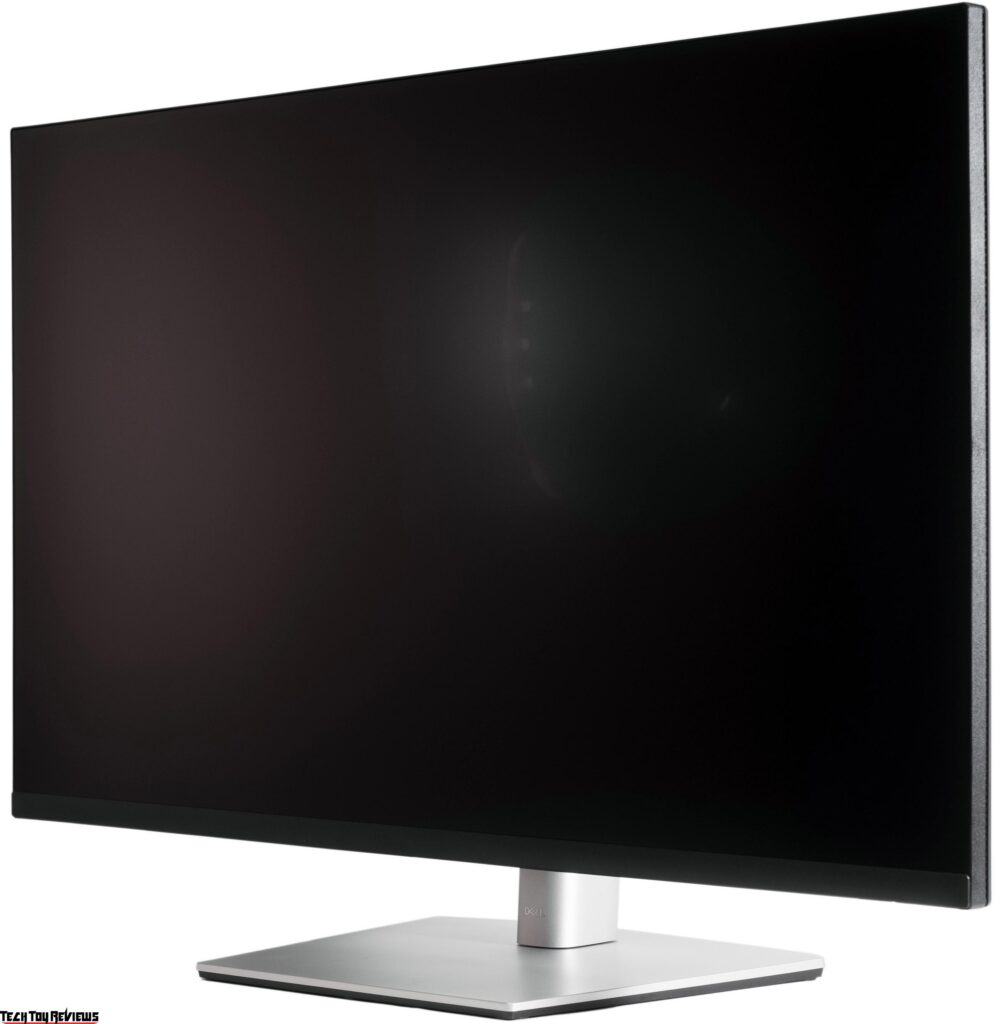
Dell P3222QE Review
Design
From a design standpoint, the P3222QE offers the already well-known Dell approach from other brand models we’ve tested over the past couple of years, and from an ergonomics point of view, it will give you a full range of features that many competitors will envy.
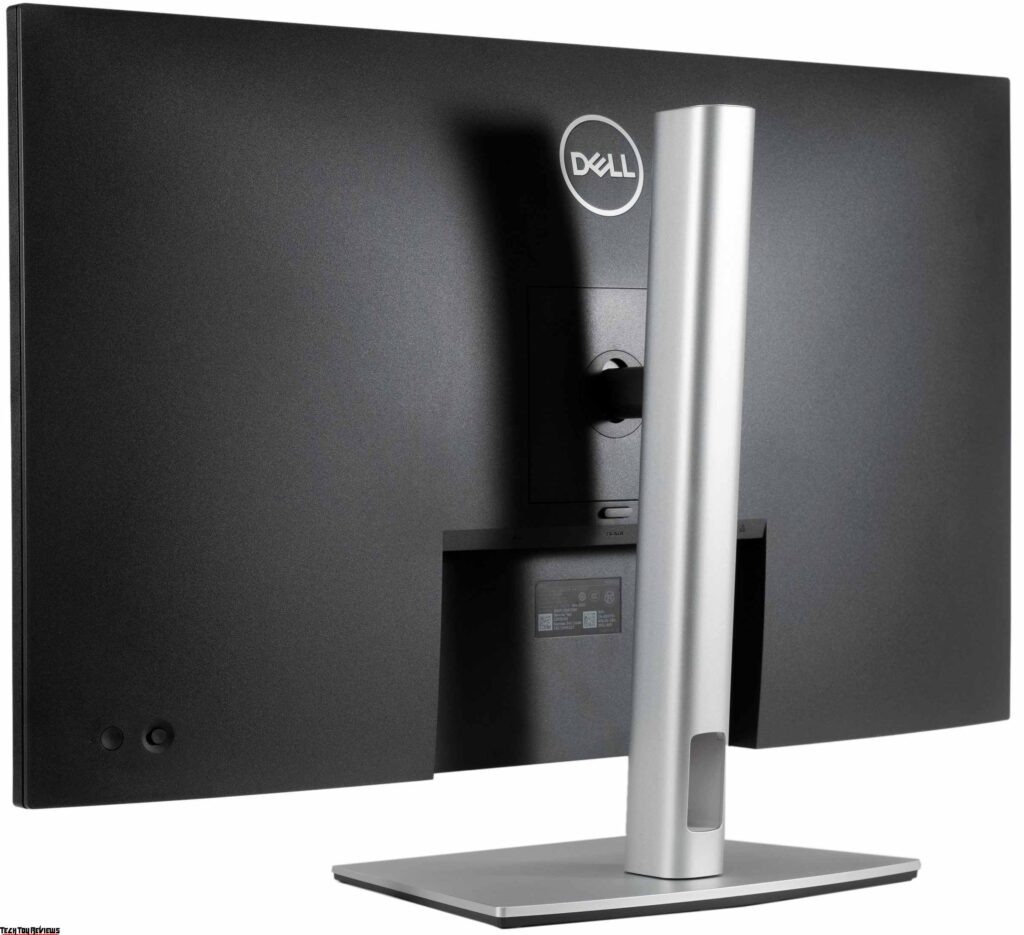
The appearance of Dell monitors rarely undergoes significant changes, and the P3222QE is no exception because its design is as close as possible to representatives of ultra-wide solutions from the top “U” line, which has not changed much in recent years.
The manufacturer used the stand and the central column, which we already know very well, and retained the high-quality matte dark gray plastic without a clearly visible texture, as is done in the most affordable models of the S series.
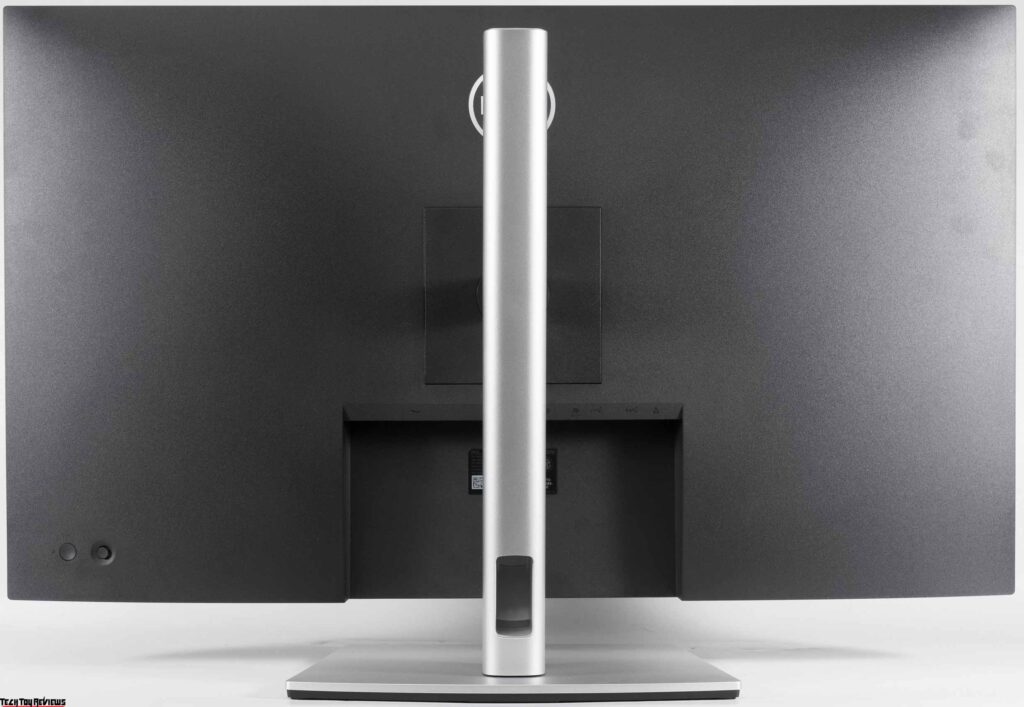
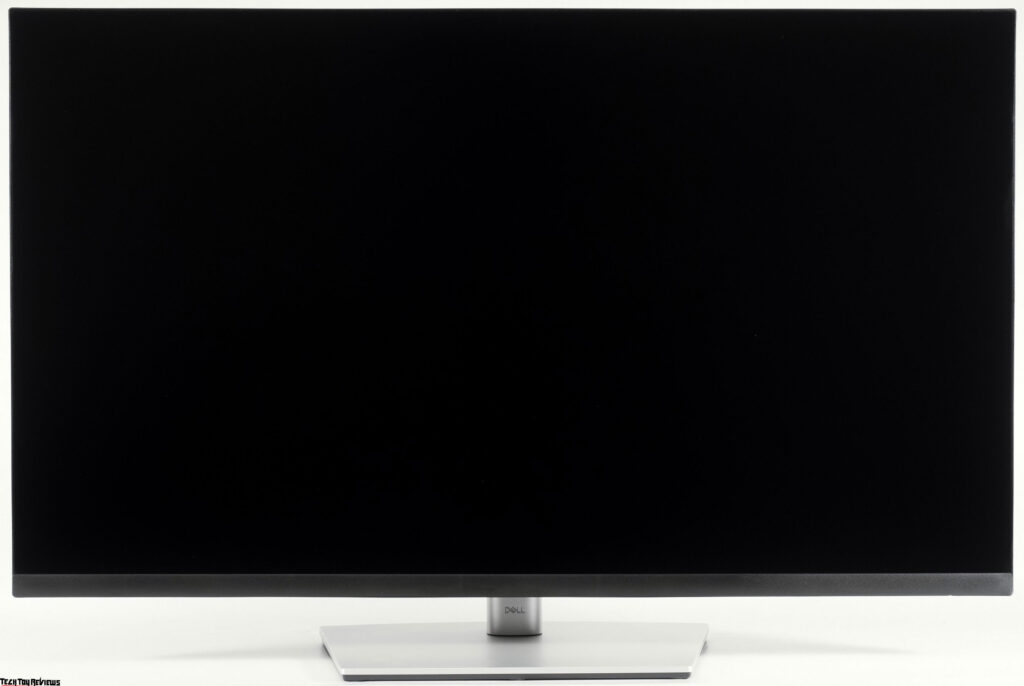
With the P3222QE, the handwriting of Dell designers is easy to read. It is simply impossible to confuse it with models of other companies.
If necessary, the Dell P3222QE can be hung on a VESA compatible 100 x 100 mm mount. To do this, at the place where the central column is attached, it is necessary to unscrew four screws, which can later be used in conjunction with the selected mount.
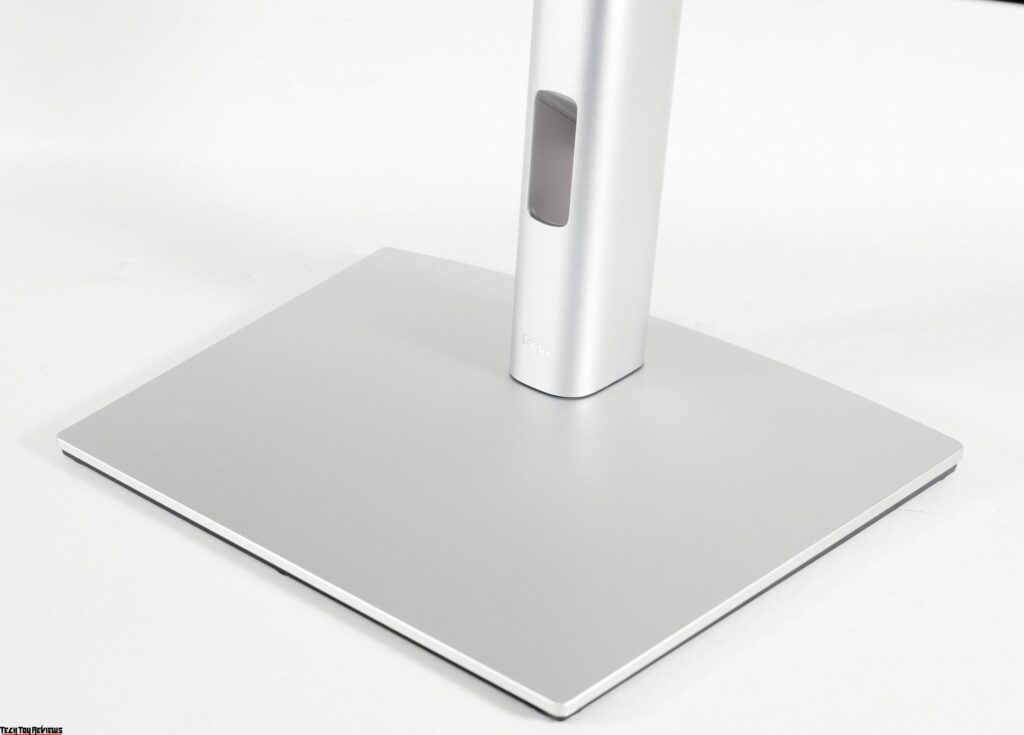
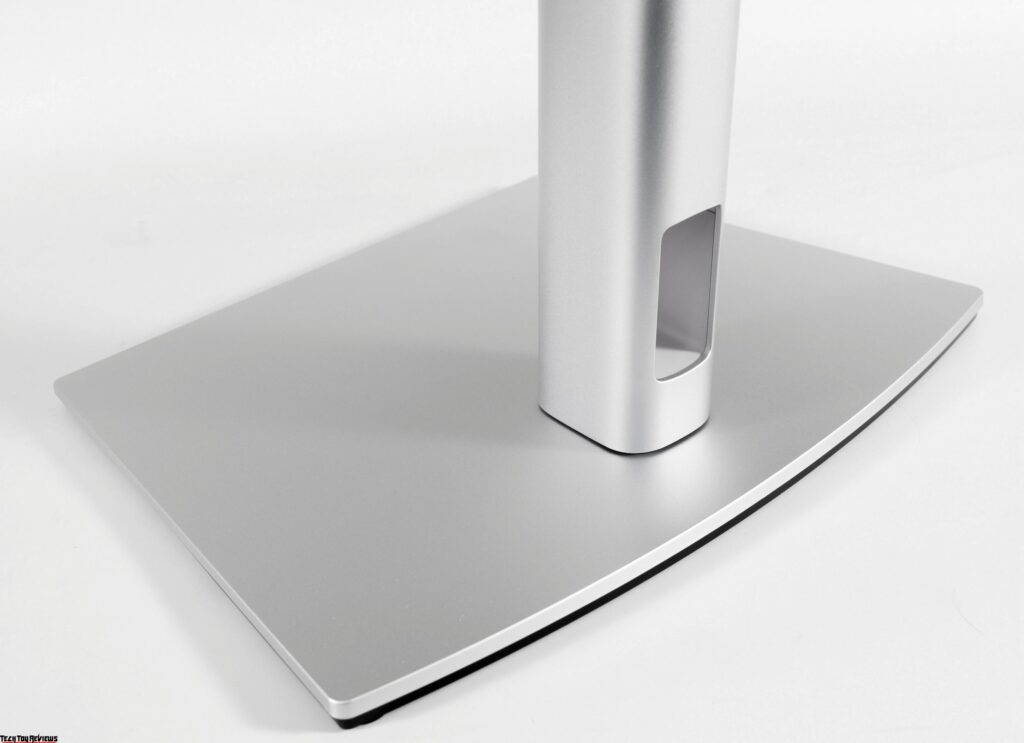
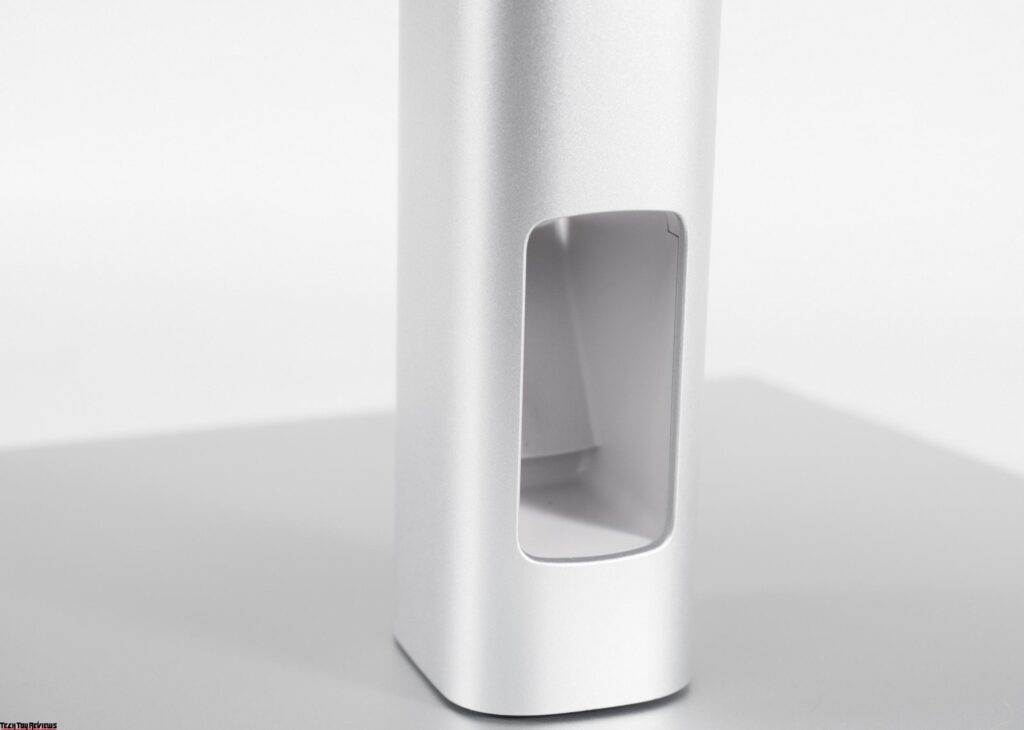
In the package, the monitor was disassembled. The heavy stand attaches in a couple of seconds without the use of tools. Dismantling is carried out just as quickly and simply – by pressing one mechanical lock button.
The fitted stand with rounded corners is similar in shape to that used in the brand’s other larger models. No complaints about stability. The top surface of the stand is made of gray plastic, reminiscent of metal. The rotary element of the central column is shifted back.
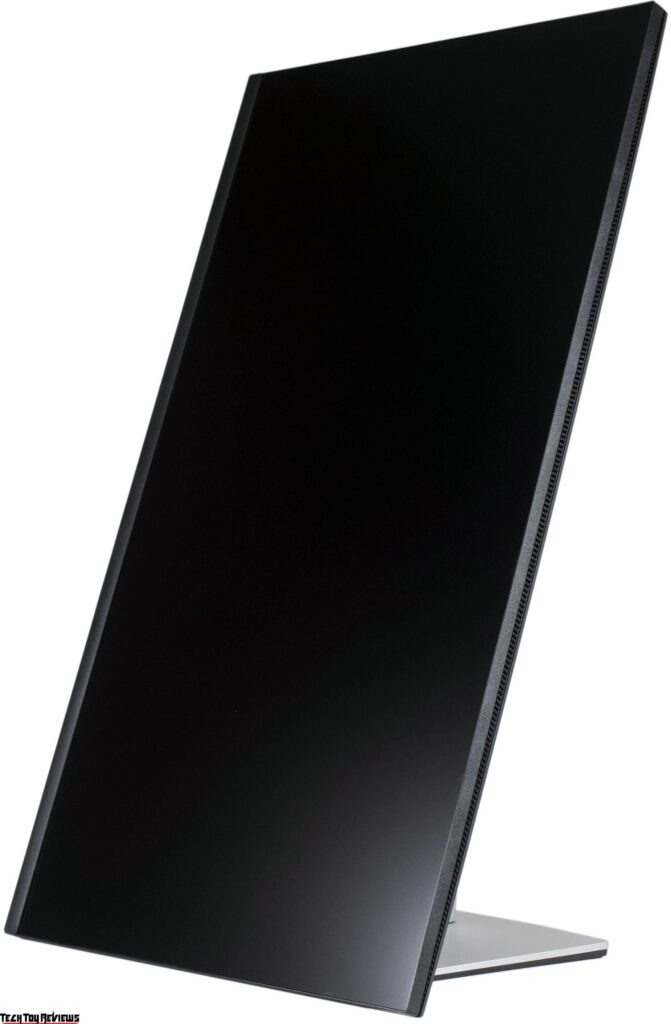
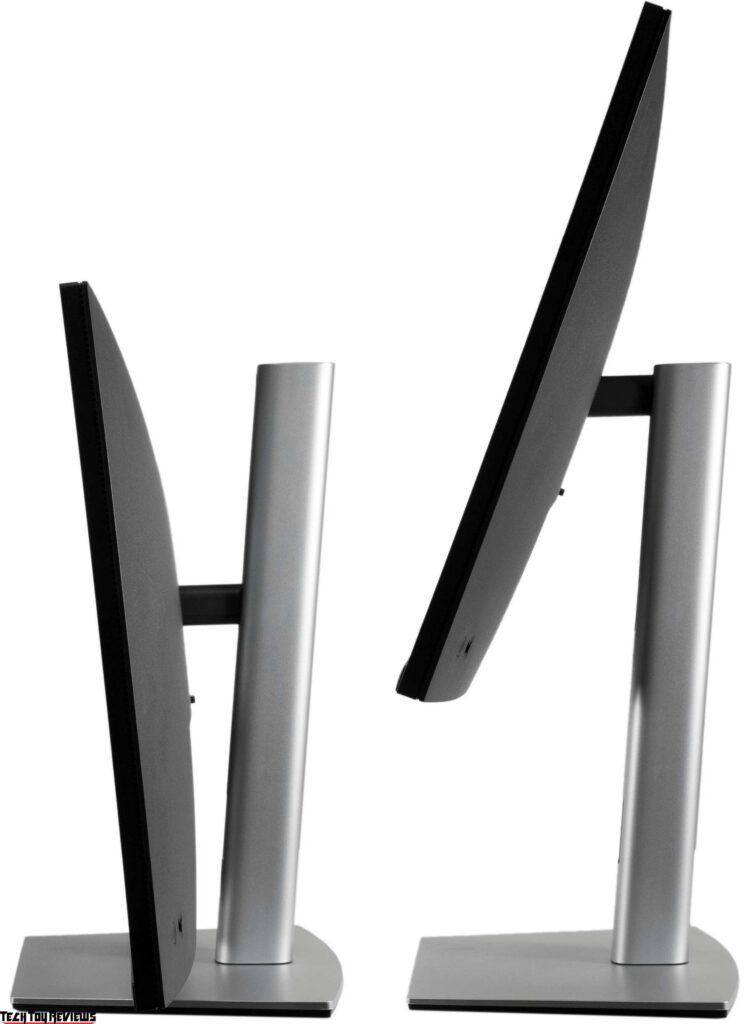
The cable management system consists of a relatively small rectangular cutout at the bottom of the B-pillar. The solution is simple and not very efficient. From an additional plastic element that hides the block along with the interface, Dell designers have long given up.
Among the changes in the 2022 model range, it should be noted that the brand name has moved from the black plastic body lining towards the front of the central pillar. Here is the development in design.
The monitor stand has standard ergonomic features for this class of Dell devices. In the case of the Dell P3222QE, you can change the panel’s tilt from -5 to +21 degrees, rotate 30 degrees left and right, change the height to within 150mm. The panel can be lowered almost to the surface of the stand and this is a big plus!
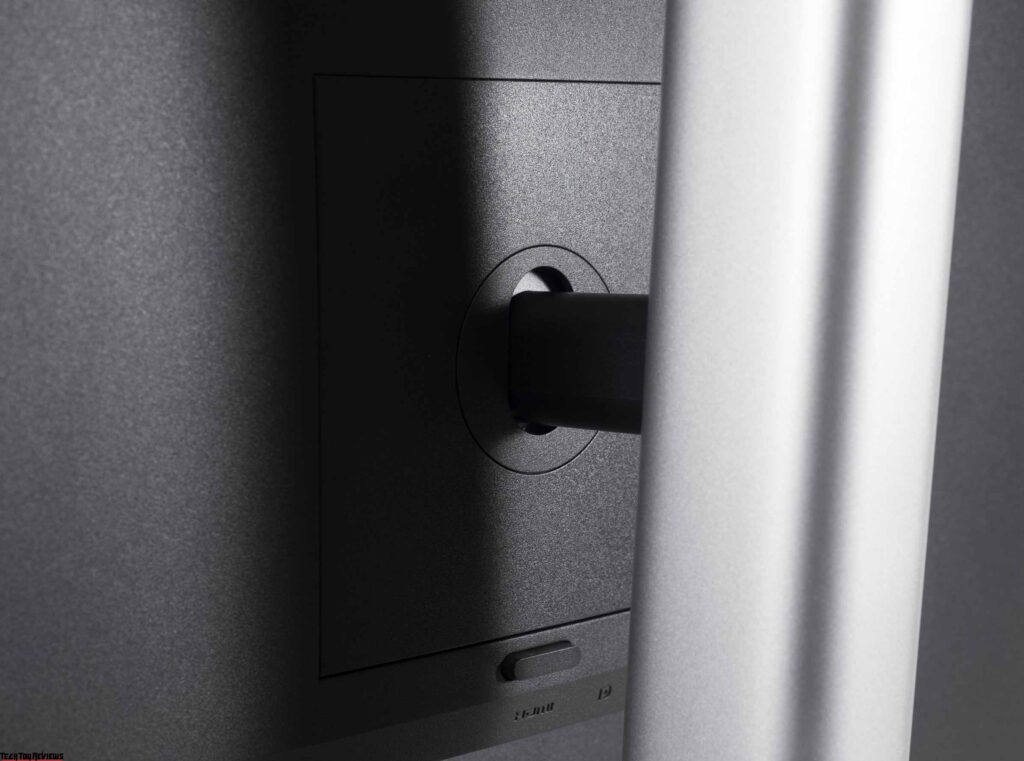

There’s also the possibility of flipping to portrait mode (pivot), the body has to be flattened after each change in position. Nevertheless, body movement on the stand is kept to a minimum, and all fasteners, inside the stand and the central pillar are made of metal.
The stand uses six rubber feet of various shapes, which do a pretty good job of holding the monitor in one position, mainly due to the heavyweight of the device.
All parts of the Dell P3222QE monitor are connected to each other with minimal gaps. The case does not lend itself to twisting, but it crunches and creaks a little when compressed and when simply moving the model from place to place. The painting of the elements is uniform, the processing of the edges of the parts is not satisfactory. The gaps between them are minimal and uniform along the entire length of the joints.
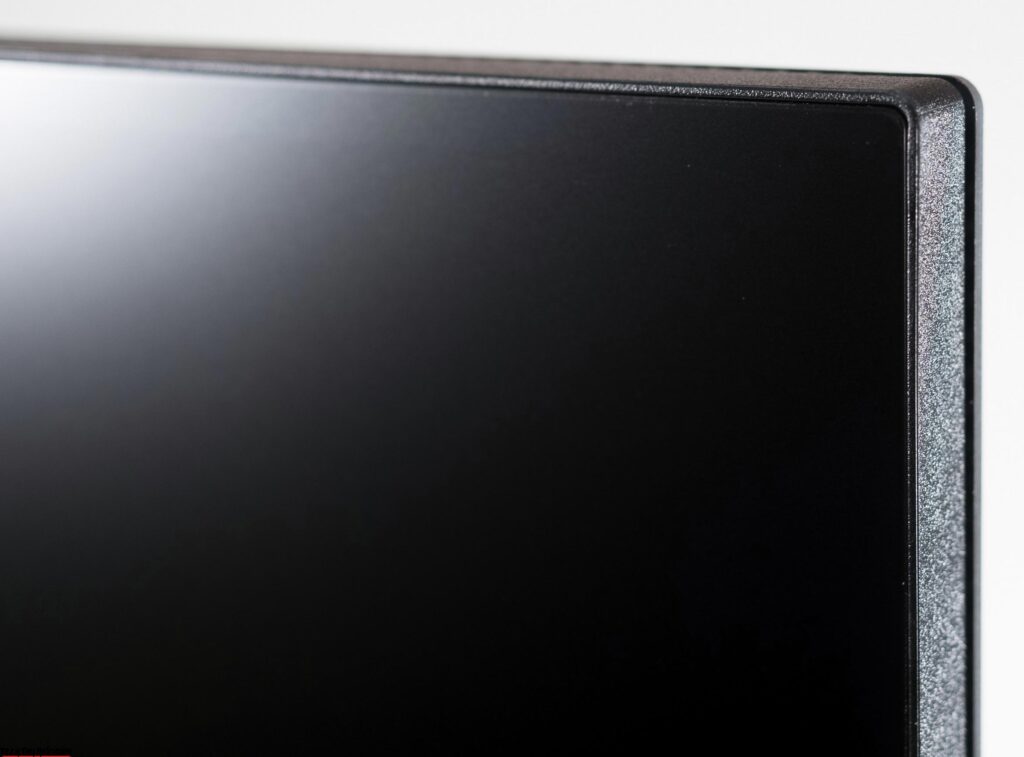
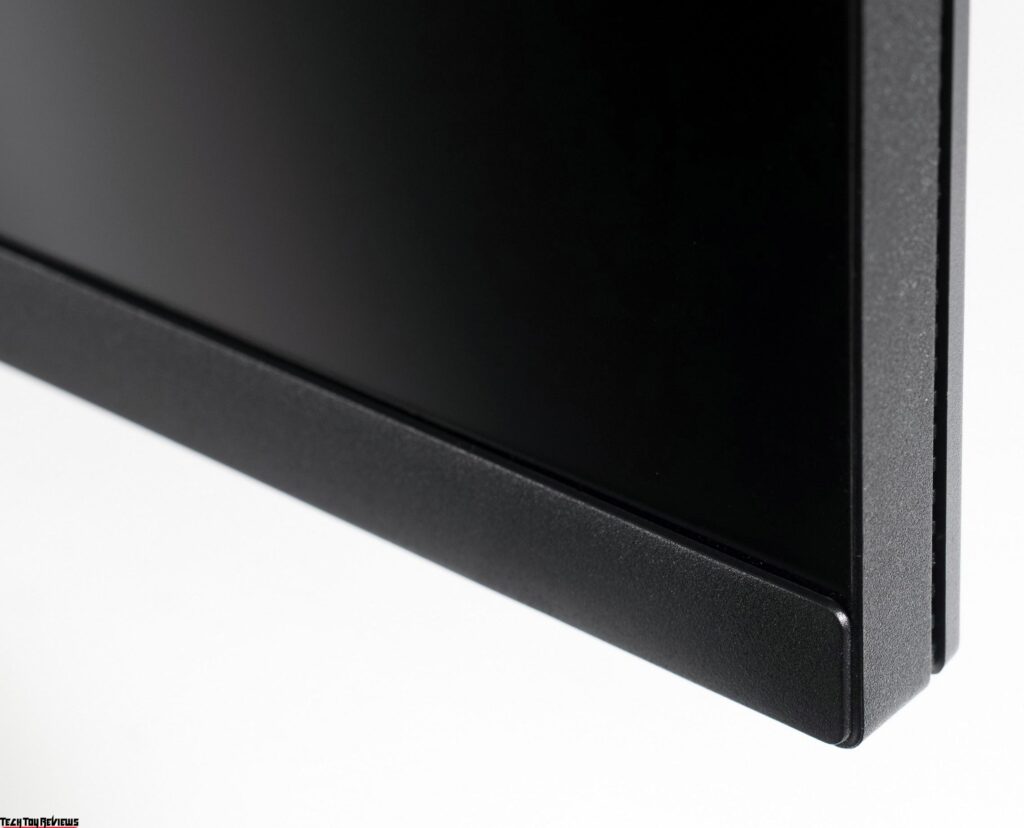
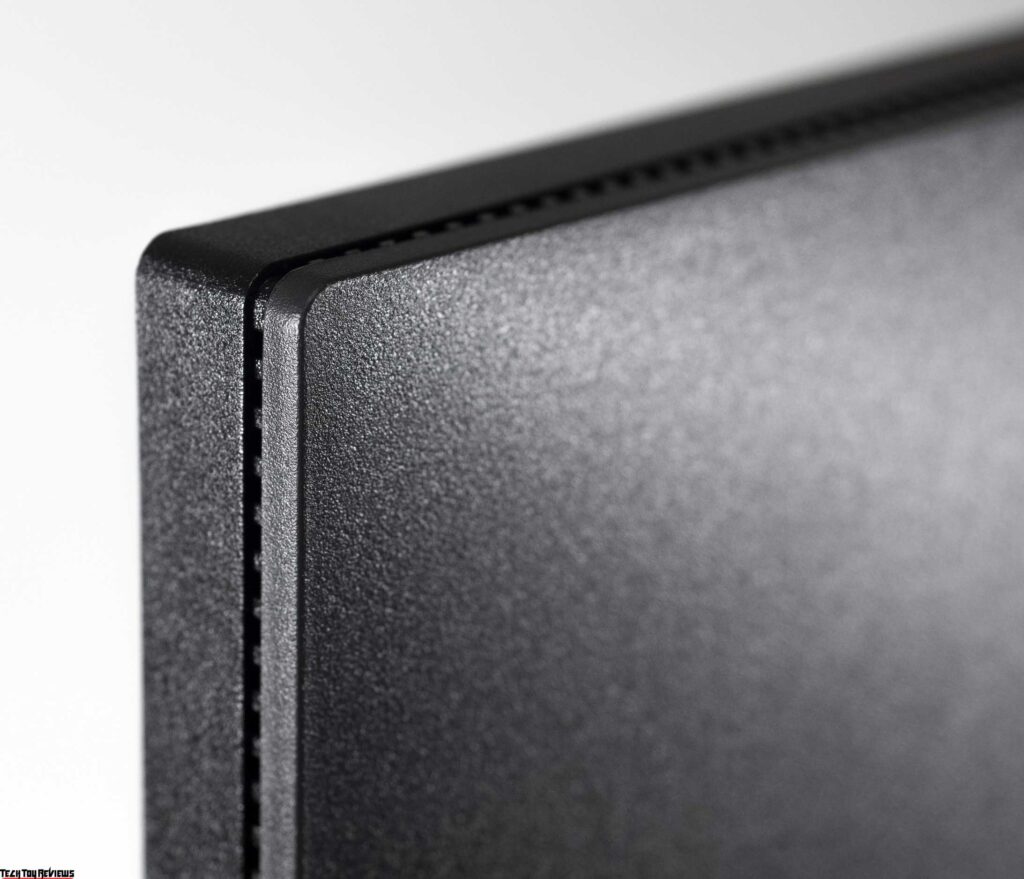
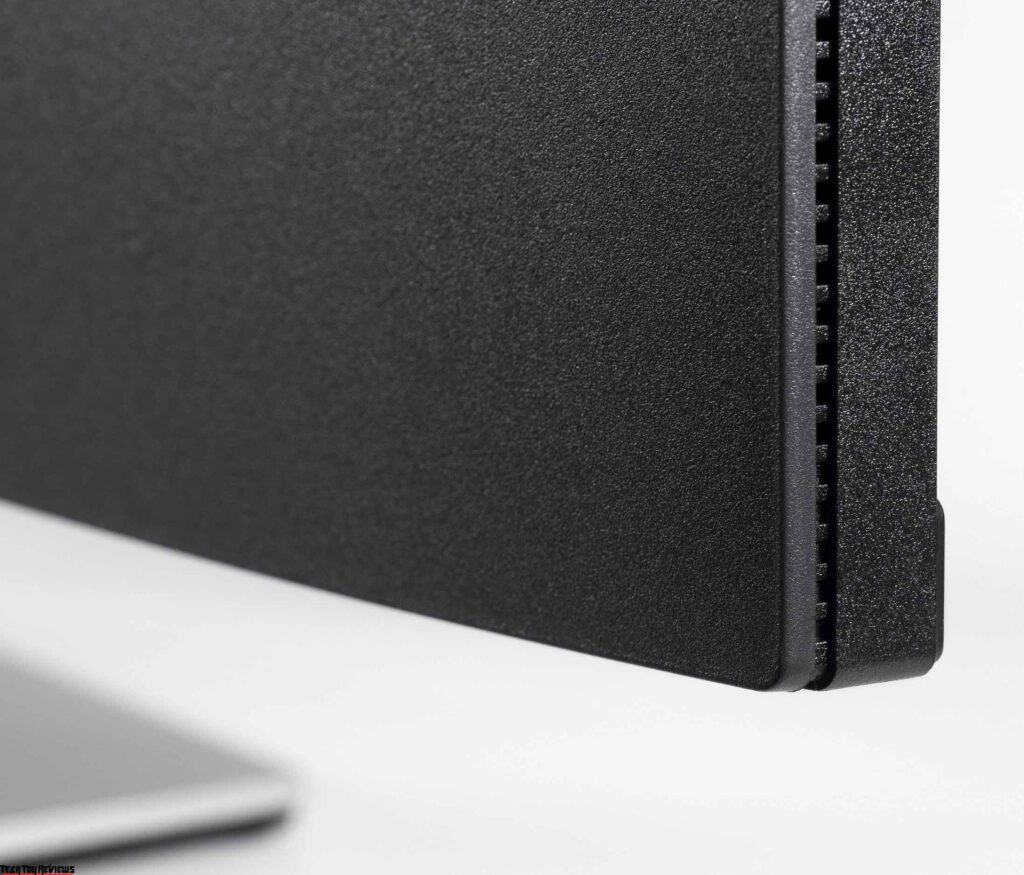
The model belongs to the “frameless design”, so you will not see the protruding frame. However, as usual, the inner frame of the matrix itself has not gone away, and even in the new panel, they remain at an average level.
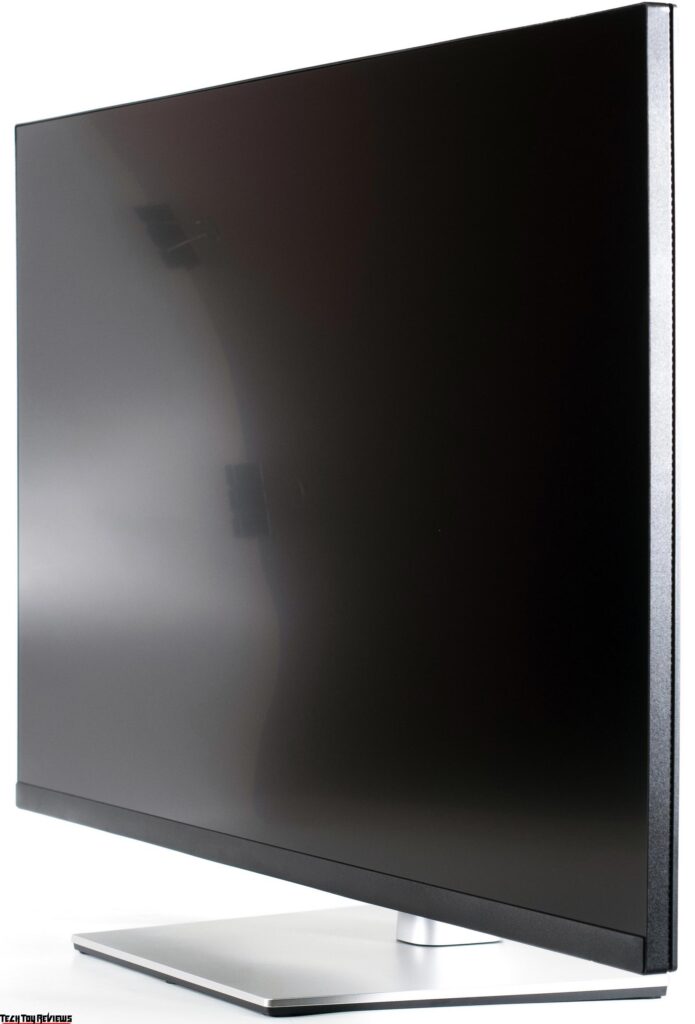
As a result, our Dell P3222QE review unit gets the maximum rating for the quality of materials and assembly, which is not surprising for a line that copies the level of performance of the top UltraSharp “U” to the maximum.
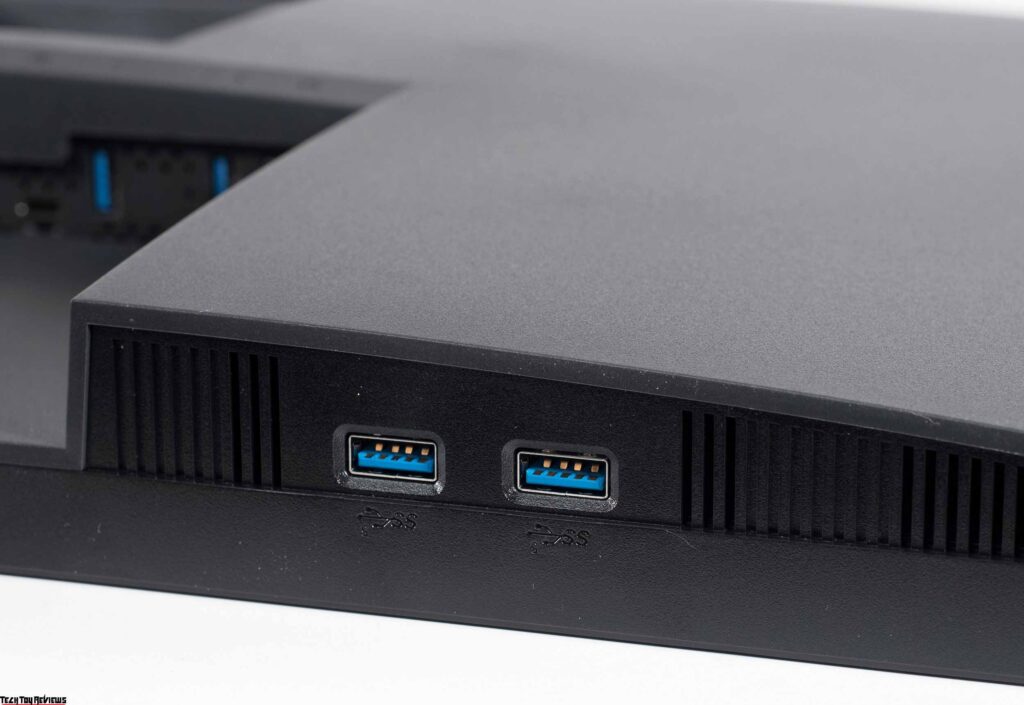

The Dell 4K monitor has a semi-matte matrix surface with appropriate anti-glare properties and low-visibility CE. The main connectors are facing down on the cable connection block, on the back of the monitor.
Two more high-speed USB 3.2 Gen1 for working with peripherals are conveniently located on a separate block on the left side of the case.


Despite the ventilation grille at the bottom and top of the case, the company hasn’t provided a built-in speaker system on the P3222QE. There is only a hint of the ability to install a branded soundbar using two built-in holder magnets on the bottom.
Display
Unfortunately, we did not know what matrix was installed in the Dell P3222QE. All we know is that it’s a 4K IPS solution with a slightly increased color gamut and otherwise fairly standard brightness, contrast, viewing angles, and response times. That might be all you need (at least 125%), given the 140 PPI scaling in the system, but some very fast-paced consumers will be able to do without it at all.
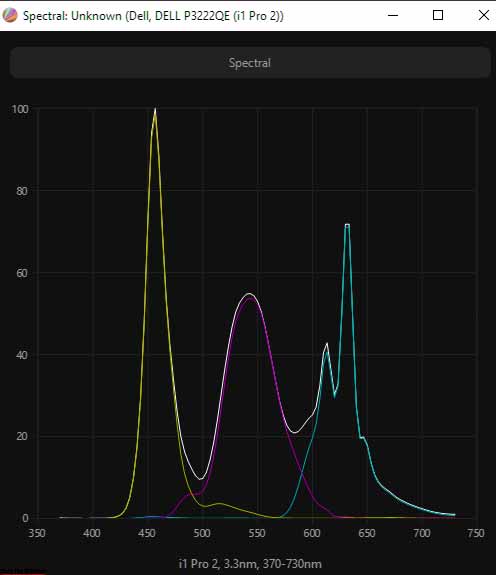
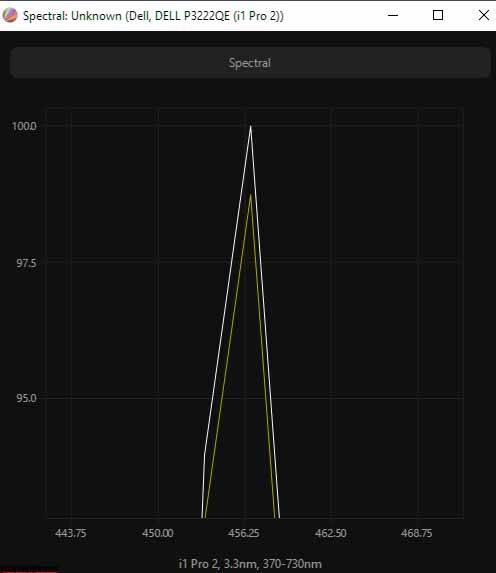
The Dell 4K monitor uses an advanced flicker-free W-LED backlight with an additional applied phosphor layer (assuming it is PFS Phosphor) to expand the color gamut and shift the peak of the blue part of the backlight spectrum to reduce eye strain. Dell called this ComfortView Plus technology.
Unlike the previously proposed ComfortView preset mode, the new Dell 32 inch monitor allows you to reduce the intensity of the glow of the blue component of the spectrum that is harmful to the eyes without concomitant negative changes – now the picture does not turn yellow, the color temperature is normal, and the load on vision is still reduced. However, we cannot say that the shift of the peak to the region of 456 nm is very significant for reducing eye fatigue. We would like to see something like 460-465 nm, as all new certificates suggest.
The panel is a 10-bit (8 bit + FRC) and is capable of reproducing more than 1 billion semitones but there is no talk of any support for HDR and adaptive synchronization gaming systems – the monitor did without them.
The Dell P3222QE monitor uses a 31.5-inch IPS panel with a semi-matte surface, designed for use in “frameless” cases.

We see the pixel structure characteristic of a modern IPS panel, more like. The surface used is not as rough as the true matte finish.
The crystalline effect practically does not manifest itself, regardless of the viewing angle. The picture on the screen does not cause discomfort and is completely free from the Cross-Hatching effect (intersecting thin diagonal lines).
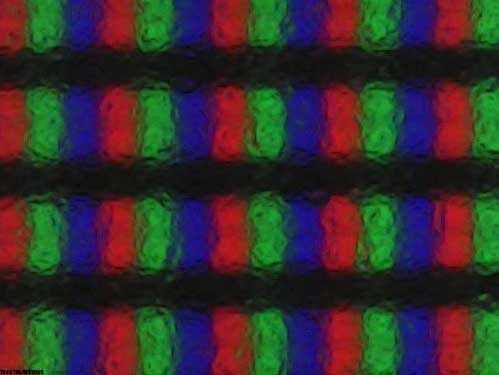
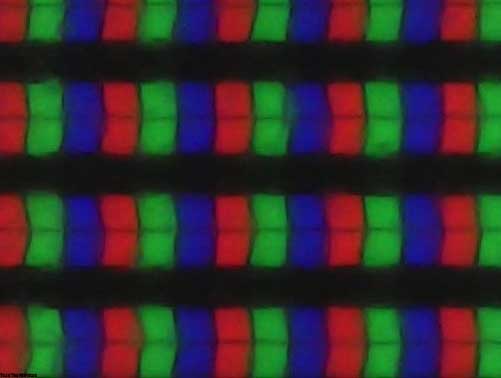
From the macro photos above, you can see the pixel structure and the protective film – shots with different focus areas of the same image segment.
Menu and controls
The Dell P3222QE monitor is controlled by a recessed power button and a five-way joystick. The status indicator hides in front but practically does not bother with its presence. Thus, the manufacturer tried to remove everything superfluous from the front panel (even the Dell logo), so that the user can concentrate only on what is happening on the screen.
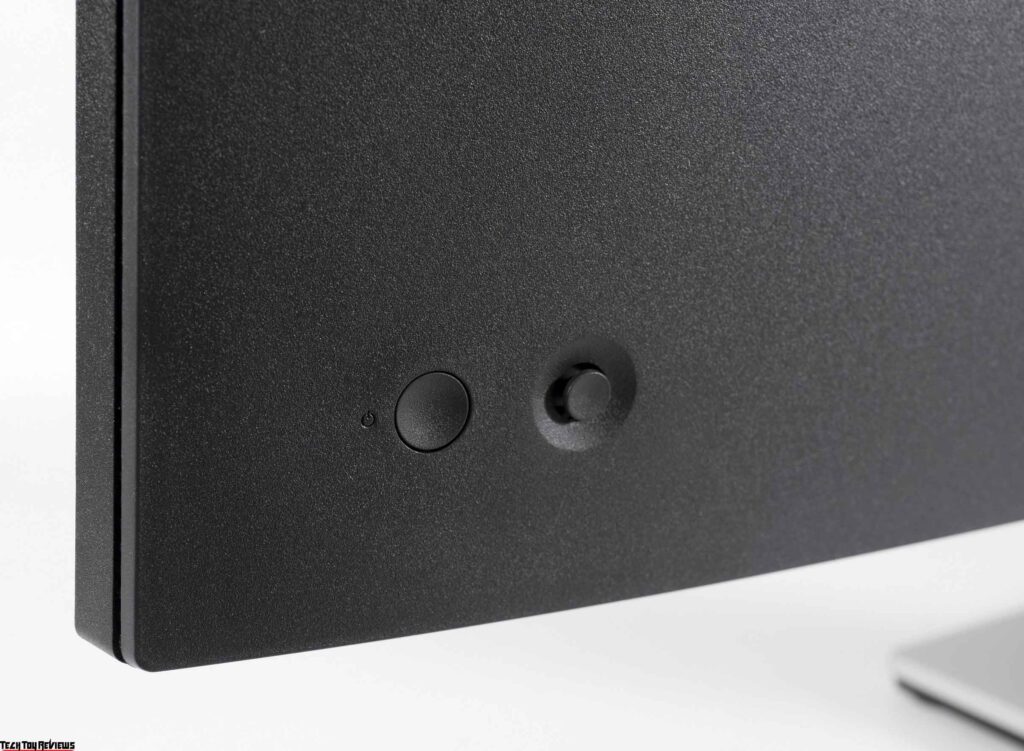
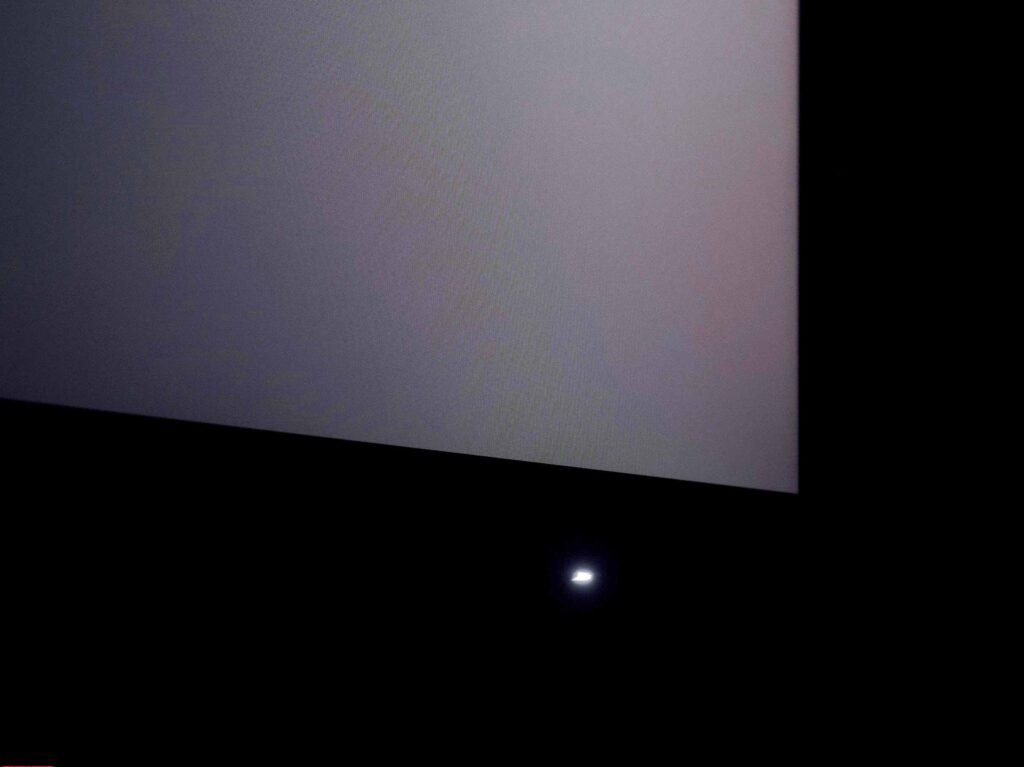
The control system is convenient, does not require getting used to, and is much more practical than the small and tight keys used in many other models of the brand.
When the joystick is moved to any position, hint icons are displayed on the screen, and first of all, they tell about the selected functions with quick access. Functions can be changed in the future in a special subsection of the menu.

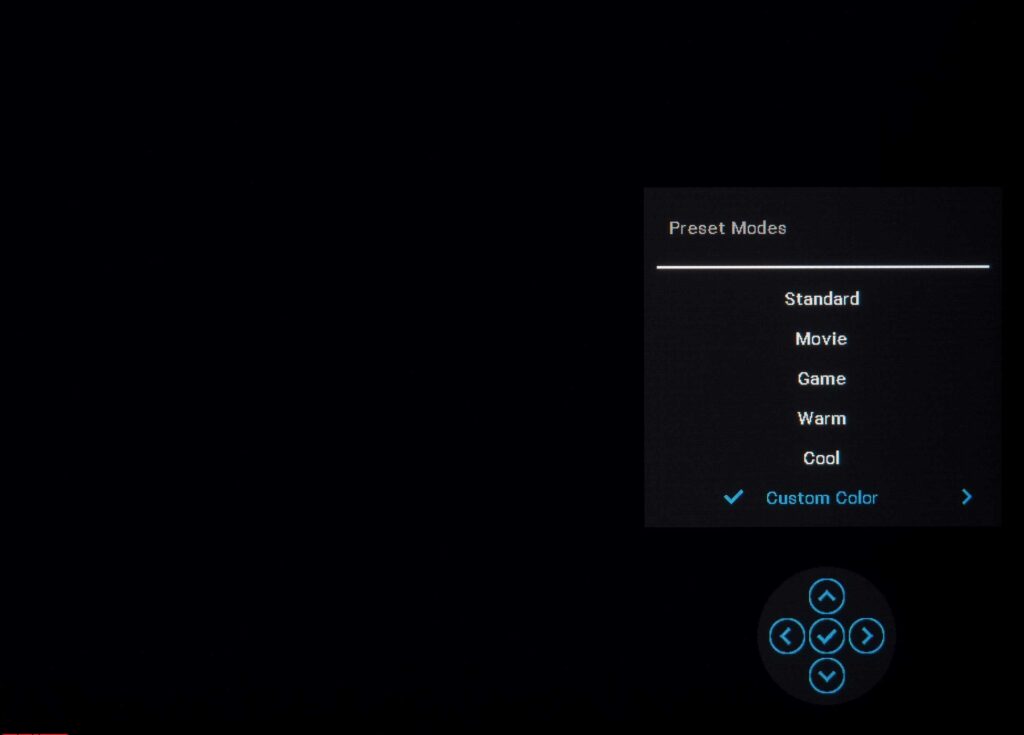
The speed of the menus doesn’t raise any questions, and navigation is simple and clear. Unless, for some reason, Dell designers used a black and blue color scheme for the initial menu and abandoned the usual black and white for the main OSD unit.
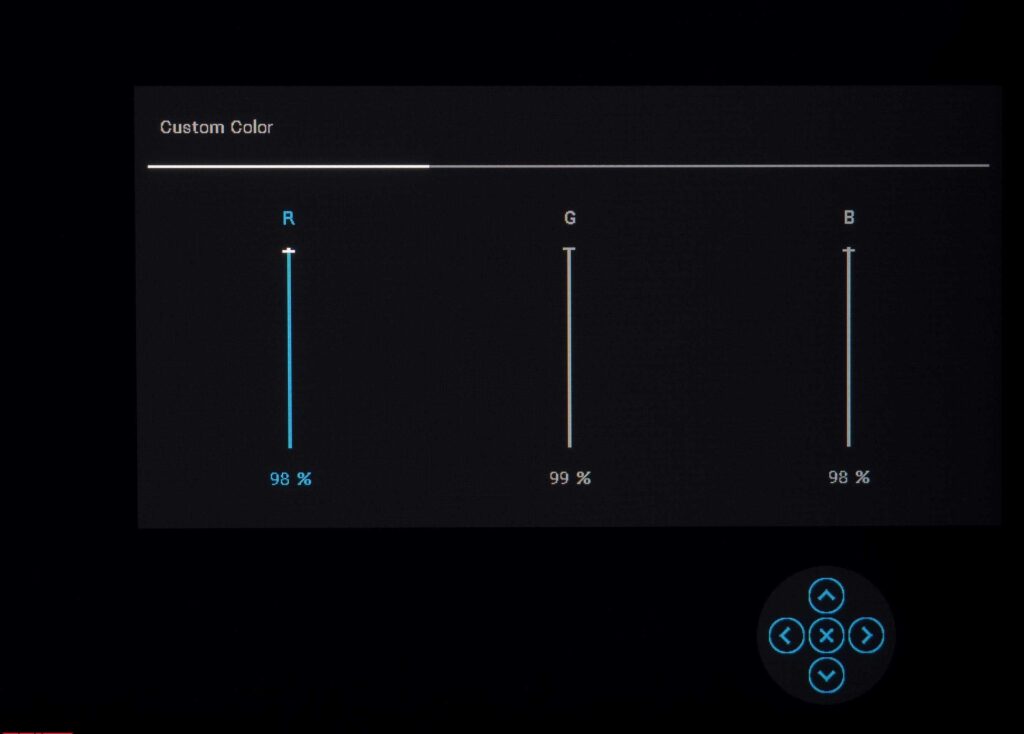
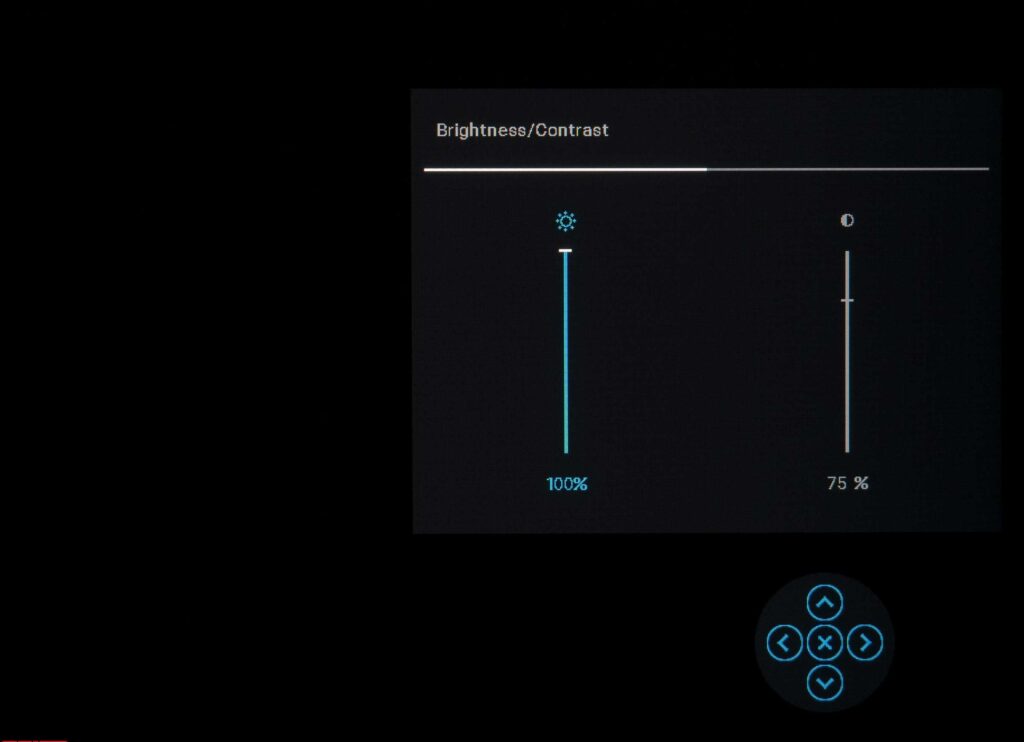
Among the options with quick access, selected by default, the following were noticed: choosing a picture mode, changing brightness and contrast, and choosing a signal source. If desired, the user can select other functions for quick access through the appropriate section in the OSD menu.
Now let’s consider the structure of the main menu, hidden behind the corresponding buttons:
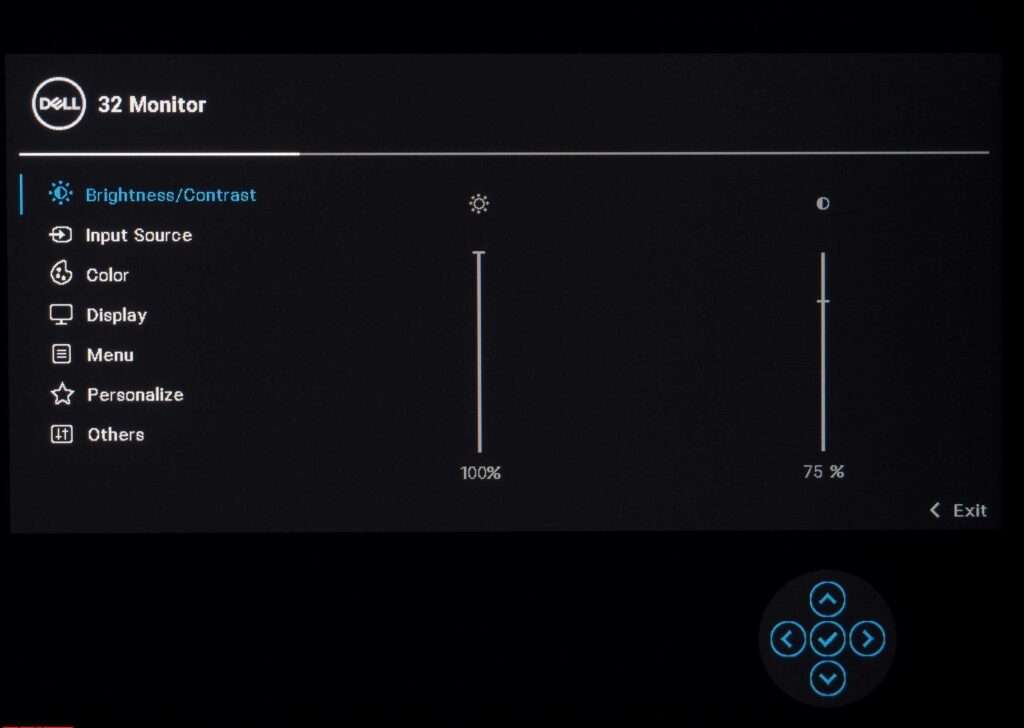
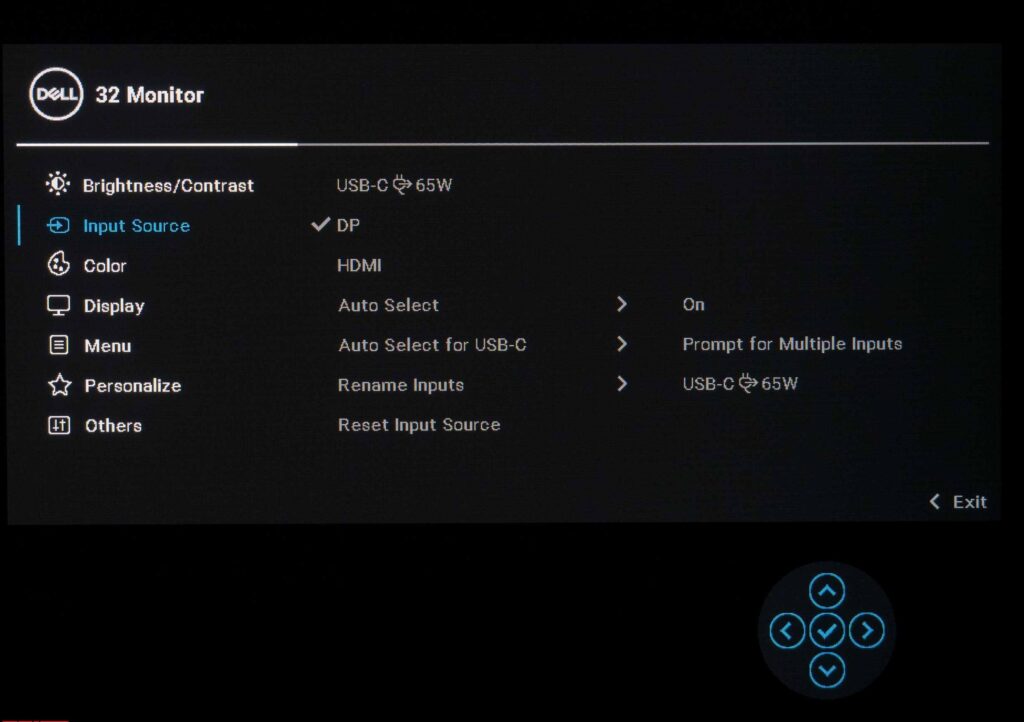
The menu has seven sections. The first one contains the brightness and contrast settings. The second one contains settings for connection interfaces and their selection.
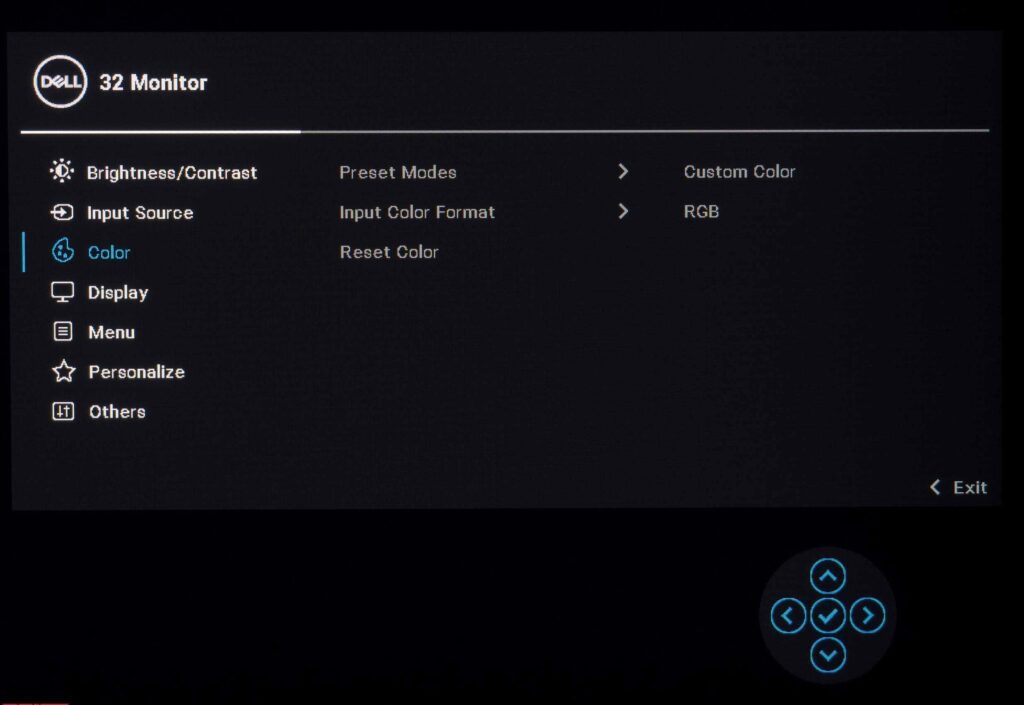
The Color section contains preset color modes, color format settings, and reset options.
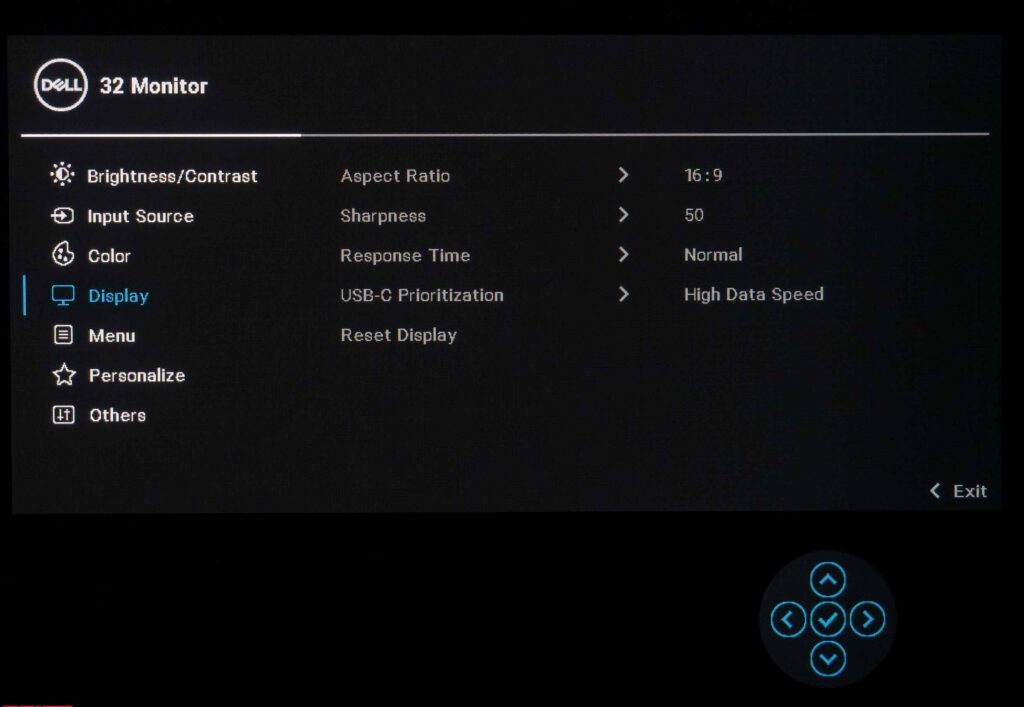
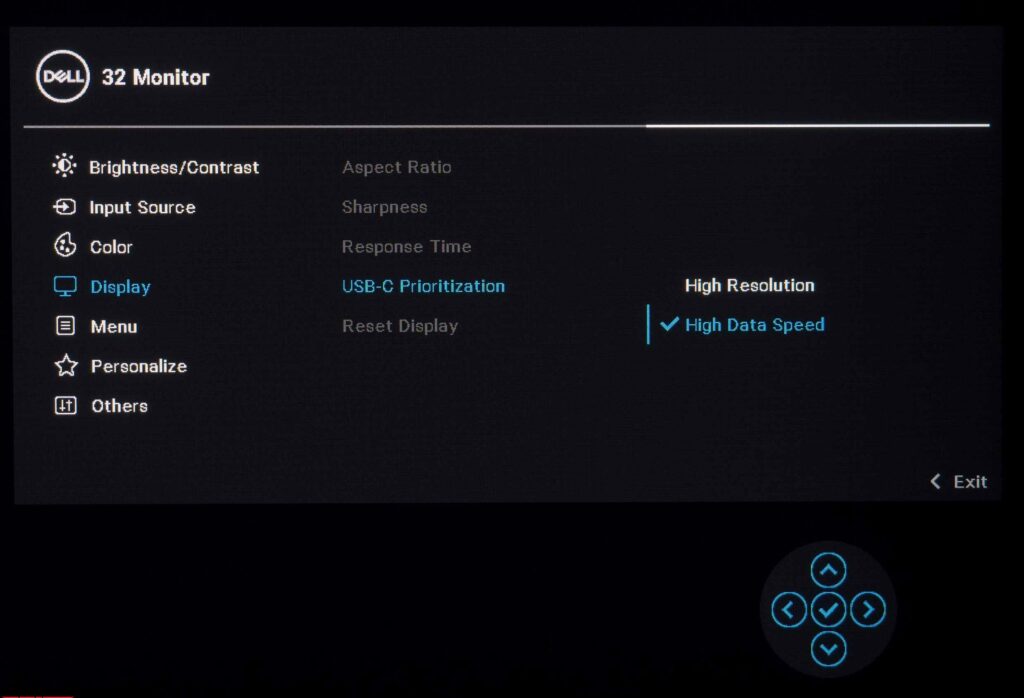
It is possible to select the operation option of the built-in image scaler, the Response Time mode, adjust the sharpness and specify the priority when using Type-C (speed for peripherals or maximum image quality – read as 60 Hz 4K without compression) in the fourth section Display.
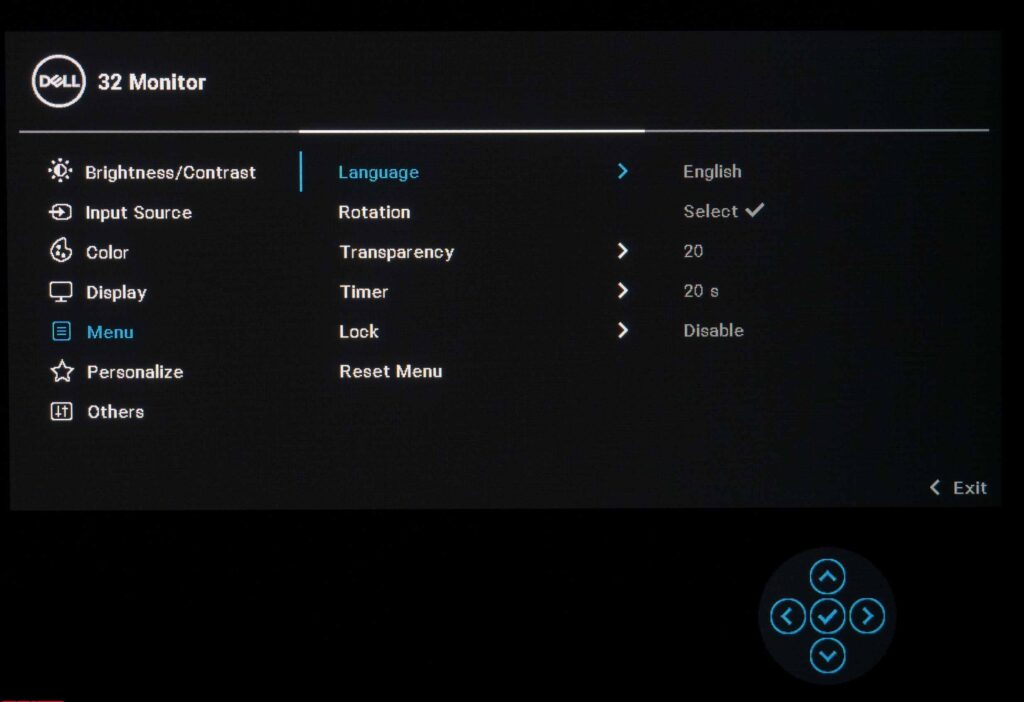
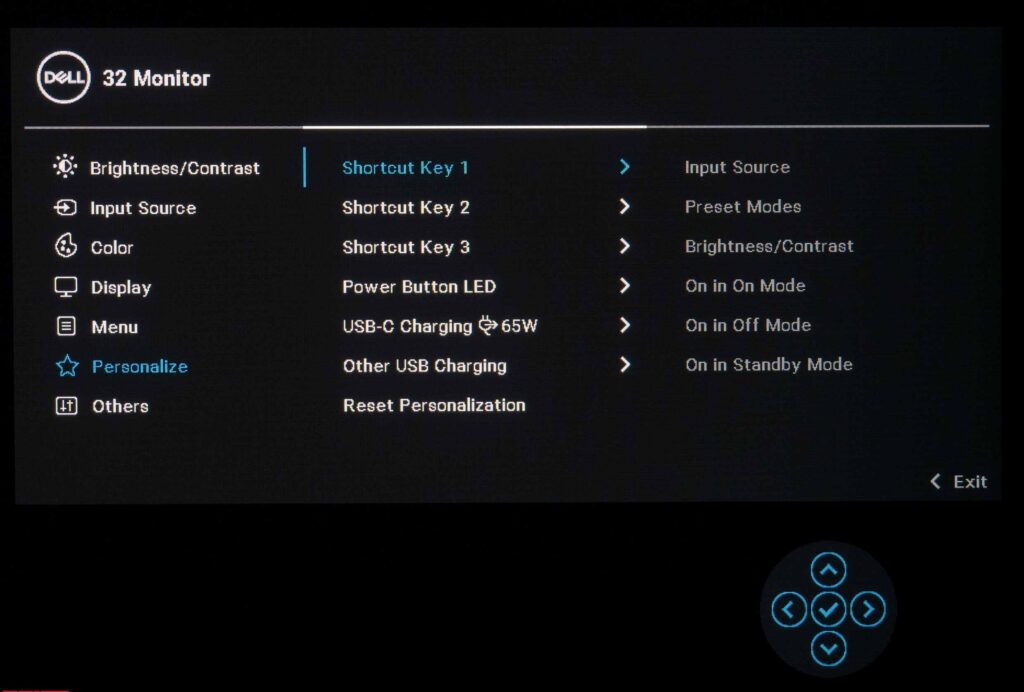
Change functions for quick access are proposed in the sixth section. There is also a setting for the power indicator, activation of the charging function for USB Type-C and USB Type-A ports, the ability to reset the settings presented in the section.
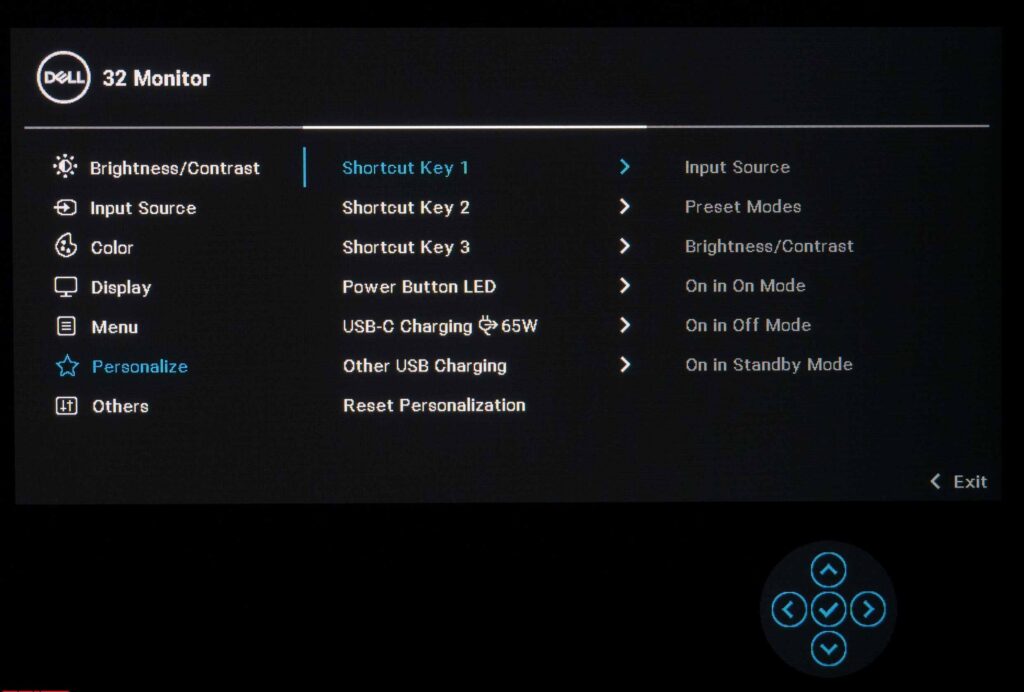
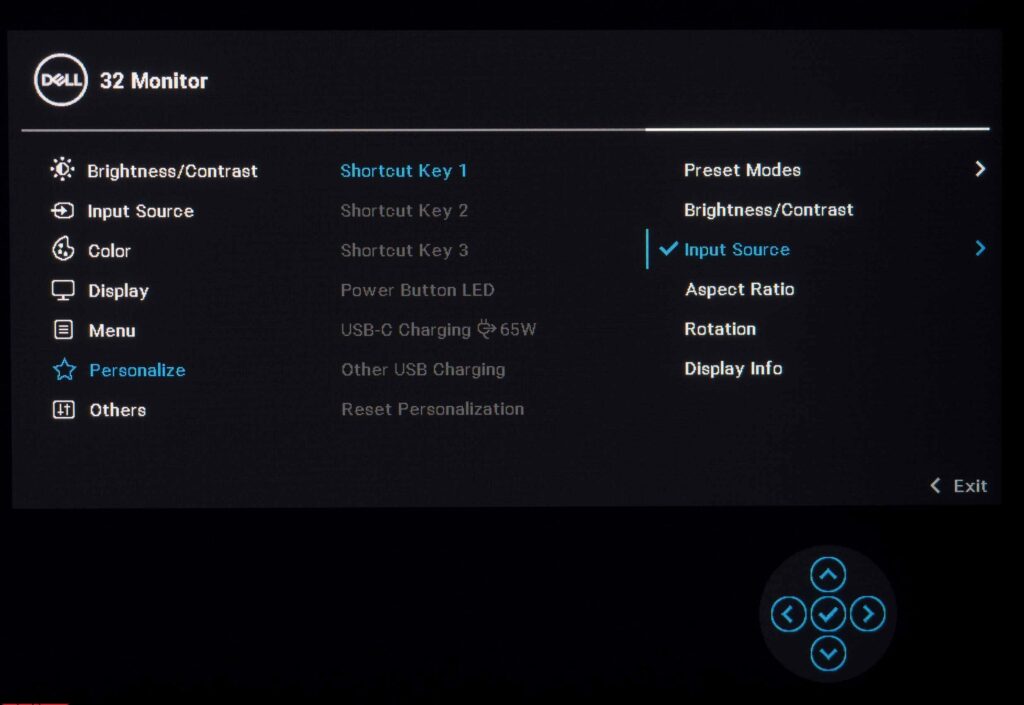
The last section allows you to disable the DDC / CI interface and activate the LCD Conditioning function to check the screen for dead pixels without using a computer (handy when buying in a store). A subsection with working information on the monitor is presented, you can also display the service number and firmware version. The Factory Reset option resets all menu settings without exception to the factory settings.
Access to the service menu was not found. The monitor turned on with any familiar key combination (for this series of displays), but nothing new appeared on the screen.
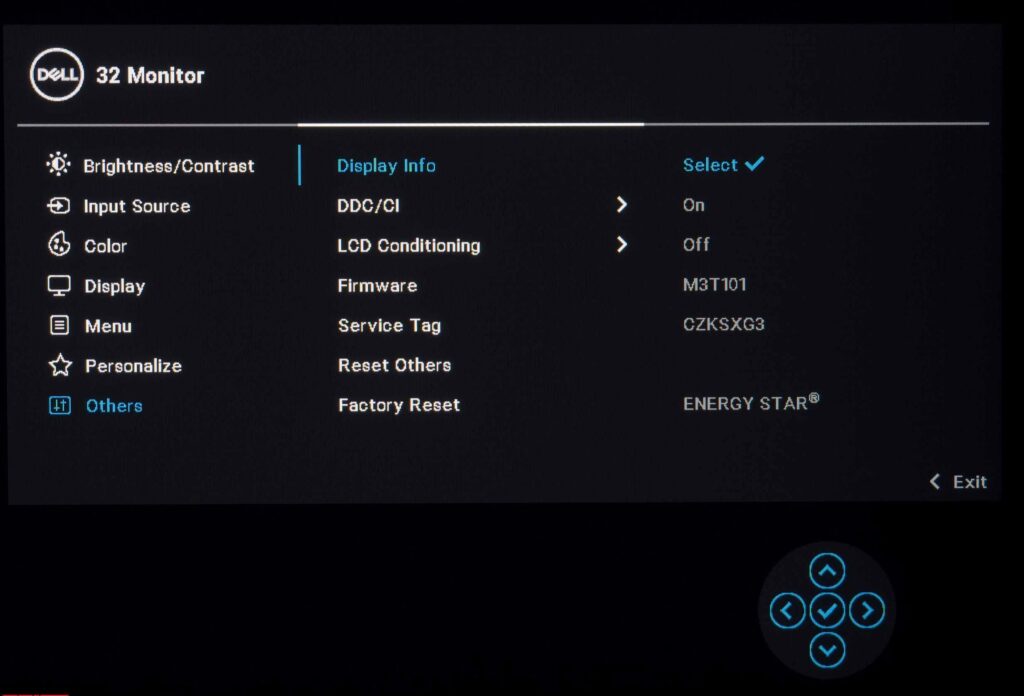
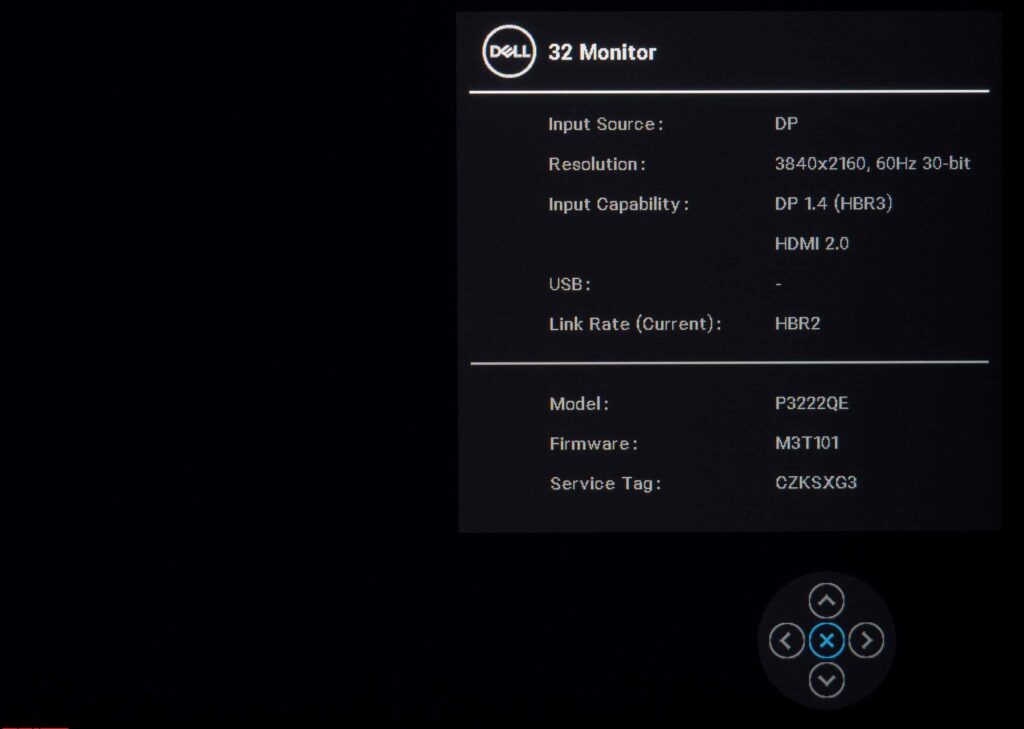
The Dell P3222QE monitor supports software management using the Dell Display Manager utility. With it, you can adjust the brightness and contrast, select the settings mode for individual applications, or customize the window layout according to user preferences. We will not talk about this utility – nothing is interesting and new in it.
Dell P3222QE specifications
- Display: 31.5-inch Anti-glare IPS LCD panel with 3H Hard Coating
- Aspect Ratio: 16:9
- Resolution: 3840 x 2160 pixels (4K)
- Refresh Rate: 60 Hz
- Pixel Pitch: 0.18159 mm
- Pixel Per Inch: 139.87
- Brightness: 350 cd/m²
- Contrast Ratio: 1000:1
- Color: 1.07 billion colors
- Response Time: 8 ms (normal); 5 ms (fast)
- Viewing Angle: 178/178
- Features: 99% sRGB color gamut, Flicker-Free technology, Mercury-free, arsenic-free glass, Dell ComfortView Plus, Security lock slot (cable lock sold separately), VESA interface support
- Ports: USB-C 3.2 Gen 1 upstream/DisplayPort 1.2 with Power Delivery, 4 x USB 3.2 Gen 1 downstream, Network (RJ-45)
- Stand: Tilt Angle -5/+21, Swivel 60, Rotation 180, Height 5.9 in
- VESA Mounting: 100 x 100 mm
- Dimensions: 28 in x 9.2 in x 24.4 in (with stand)
- Weight: 22.05 lbs
Dell P3222QE Review Test
Color gamut
The Dell P3222QE monitor uses a 4K IPS panel with an advanced W-LED backlighting variant, where an additional sputtering layer is used to modify the backlight spectrum and slightly expand the color gamut. Of course, which is a side effect of these changes. Let’s examine its color gamut using our Dell P3222QE review unit.
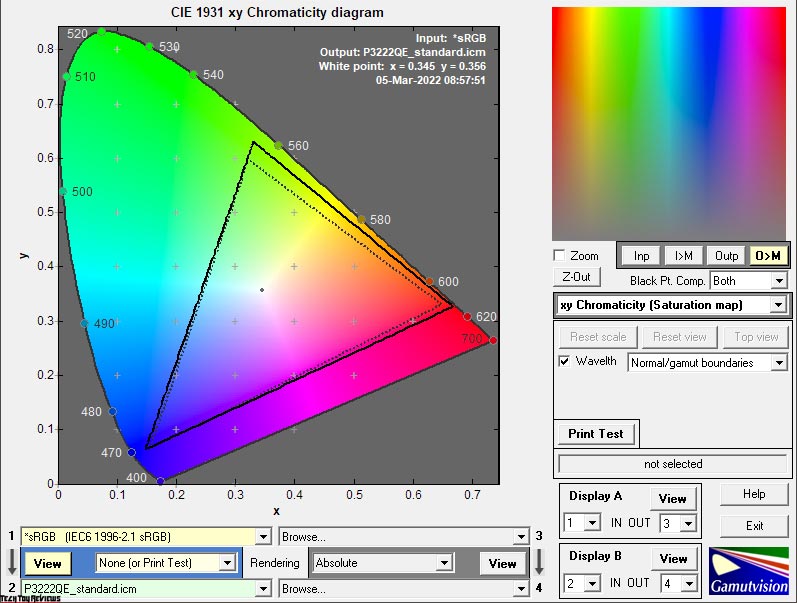
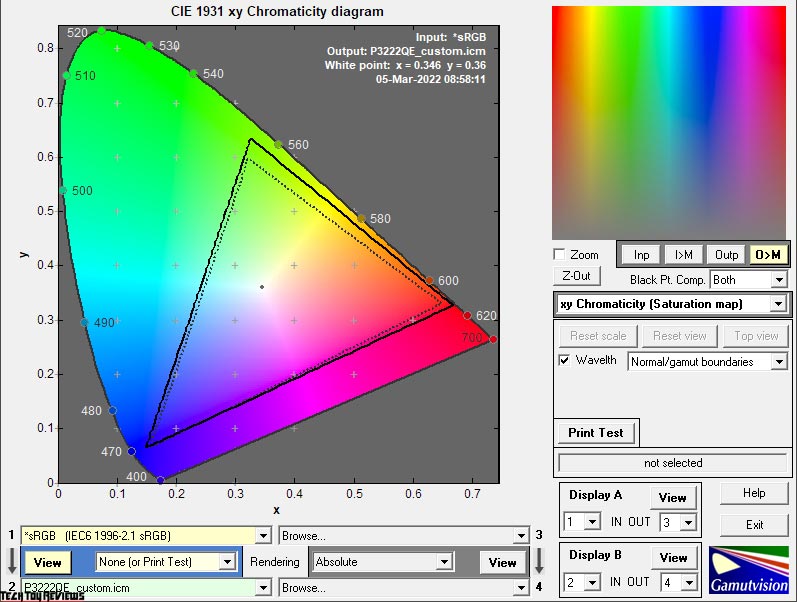
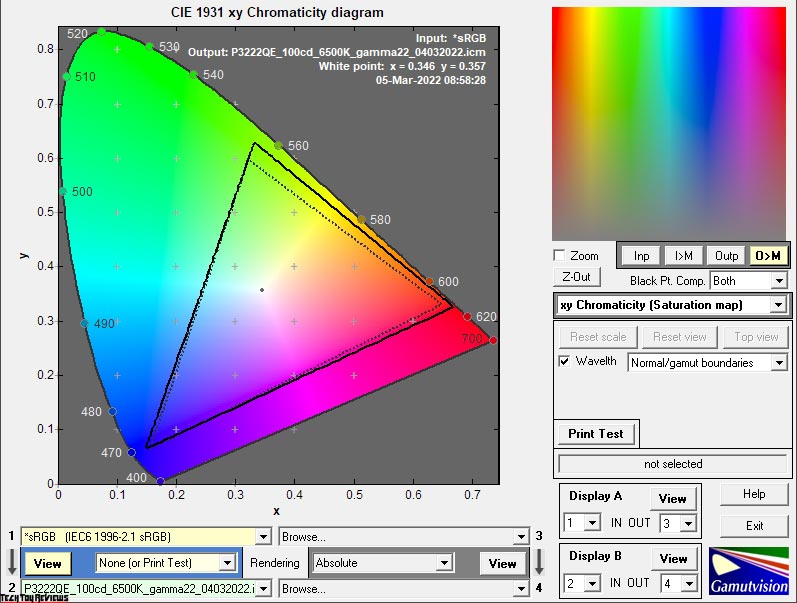
The initial check was carried out with the factory settings of the display. The screenshots show that the monitor is superior in its capabilities to sRGB (for which the manufacturer claims 99% coverage) exclusively on the green, yellow, and orange stimuli. Such excess cannot be attributed to a full-fledged extended color tone, which we are used to in the latest innovations in the monitor market, but, in any case, the user can easily experience a richer picture, which he may like or not.
The monitor demonstrates similar capabilities in the Custom mode for manual adjustment, including after adjustment and calibration. It should be noted here that the P3222QE does without the sRGB emulation preset, and therefore, if you want to get a more correct picture in terms of color accuracy, you should worry about the operation of the color management system and its settings in the software you need in advance.
The final results of the color gamut compliance with standardized spaces (the second digit is the color volume) are as follows:
Standard settings:
- sRGB – 99.7|119.1%
- AdobeRGB – 74.6|82.1%
- DCI-P3 – 84.2|84.4%
Custom mode:
- sRGB – 99.7|121.5%
- AdobeRGB – 76.1|83.7%
- DCI-P3 – 85.9|86.1%
After setup and calibration (Custom):
- sRGB – 99.6|119.2%
- AdobeRGB – 74.6|82.1%
- DCI-P3 – 84.2|84.4%
All values were obtained by profiling in the Argyll CMS environment, with shaded and color clipping going beyond the bounds of the reference values. The Dell P3222QE monitor fully complies with the basic requirements for working with color in the standard sRGB color space, confirms the numbers declared by the manufacturer in TX, and even slightly surpasses them.
Speaking of shades that surpass the studied standards, it can be noted that it is possible to deal with them by the method already known to you – using ICC / ICM profiles and software with normal support for the color management system (CMS). Among them: Adobe products, Google Picasa, XnView, Windows Photo Viewer (7, 8, 10, 11), Firefox, Google Chrome, etc.
Brightness, contrast, and color ratio
The Dell P3222QE monitor in question has three main modes, two additional modes with different color temperature preset (cold and warm), as well as a Custom preset for manual correction. By default, Standard Mode is used with the following settings:
- Brightness – 75
- Contrast – 75
- Response Time – Normal
Let us study the results presented in the table below:
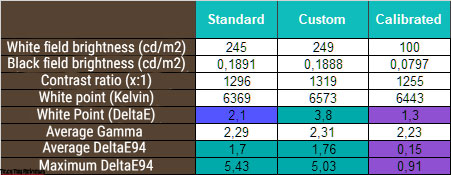
The brightness of the white field in the studied modes is at an average level and is as similar as possible. There are no questions to the P3222QE regarding the contrast ratio – the model can conquer 1300:1, which is a very high result for modern IPS displays.
The white point is factory set to above average and for most users may need to be corrected only after a strong decrease in backlight brightness, when the level of deviation increases. When switching to Custom, the level of deviation almost doubles, however, the white point becomes extremely close to 6500K, and it only shows that there is a parasitic shift.
In terms of the overall level of color accuracy, the model exhibits an average level – similar to both Standard and Custom. Factory color rendition has an increased contrast relative to the reference, as well as the same halftones that have gone beyond the limits of the sRGB standard. Therefore, nothing is surprising in the average price of the DeltaE94 in the order of 1.7-1.8 units and 5-5.4 in maximum.
For a brightness of 100 nits, a white point color temperature of 6500K, and other improvements, we switched to Custom Mode and set the following settings:
- Brightness – 24
- Contrast – 75
- RGB Gain – 98/99/98
- Response Time – Normal
Manual adjustments allowed us to reduce the brightness to the desired level and set the white point close to 6500K with minimal deviations. After applying the created correction profile, the overall color accuracy increased to the level of 0.15 DeltaE94 units on average and 0.91 at the maximum – a result that the installed matrix and monitor of this class deserve.
Gamma curves and gray balance
With the help of the HCFR Colormeter program and the “calibrated” X-Rite Display Pro colorimeter, we studied the gamma curves in all the “modes” discussed above, both initially preset and especially “developed”. In addition, according to the measurements made, it is possible to evaluate the divergence of the gray wedge (points of the black-and-white gradient) on the CIE diagram and draw conclusions about the predominance of one or another spurious hue, or its absence.

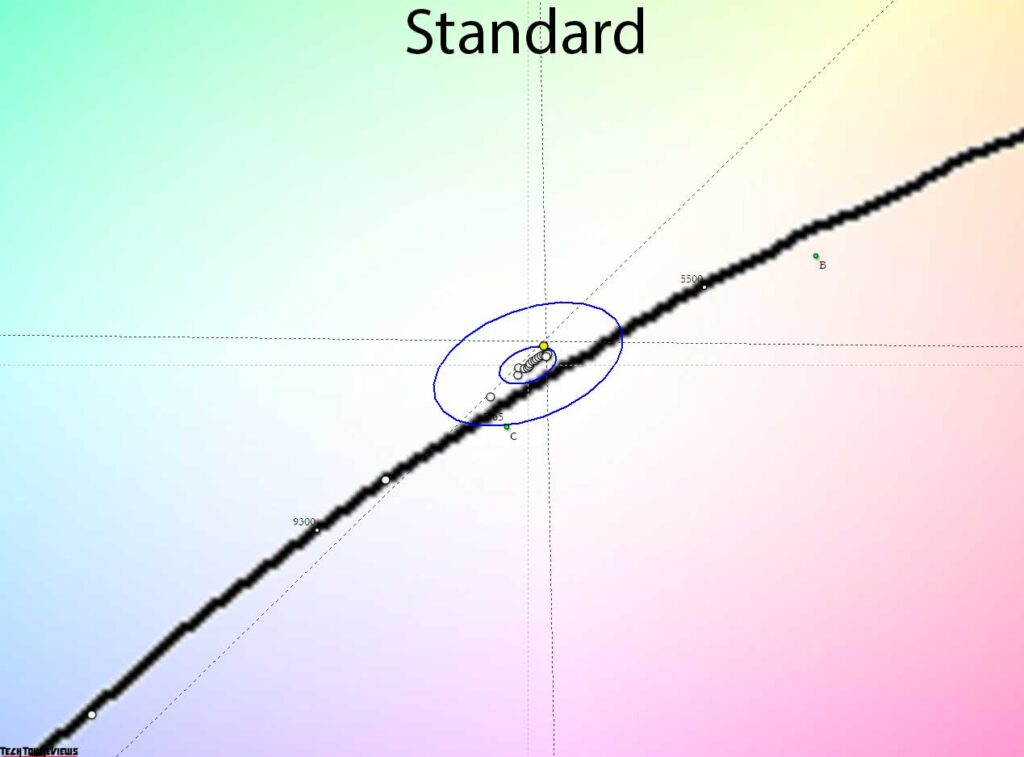
At standard settings, the measured gamma curves are significantly below the reference in the range of 30-90%, which leads to an increase in the contrast of the image on the screen. At the same time, the spread between the RGB channels is small, which ensures sufficiently high stability of shades of gray, lying in the DeltaE<3 zone in a relatively dense group.
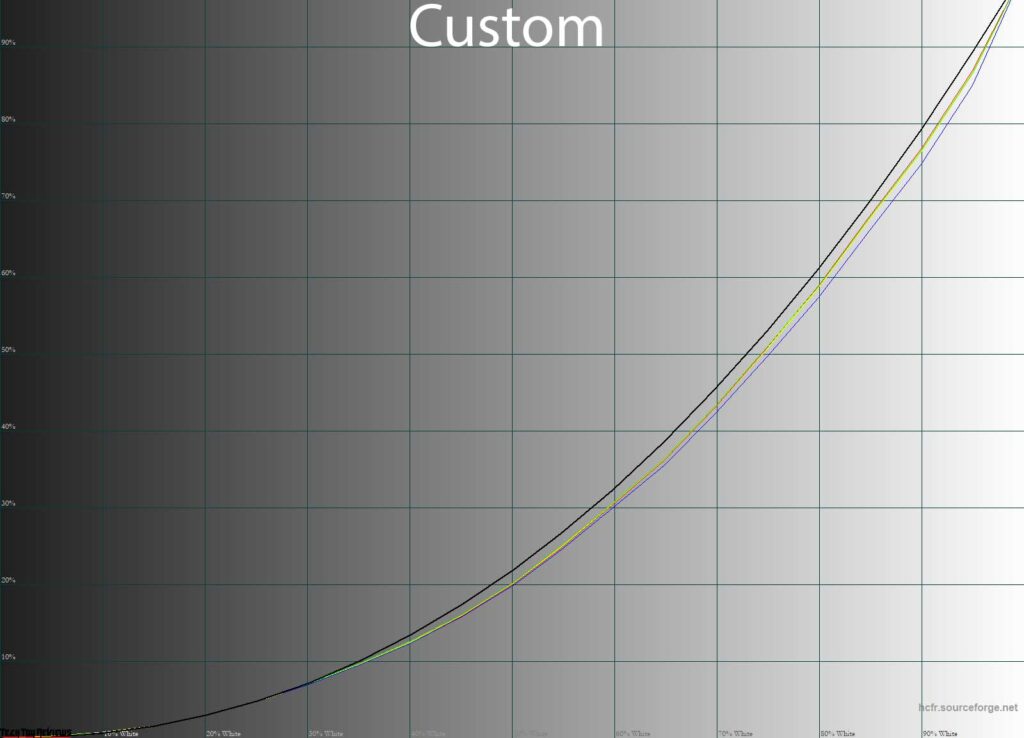
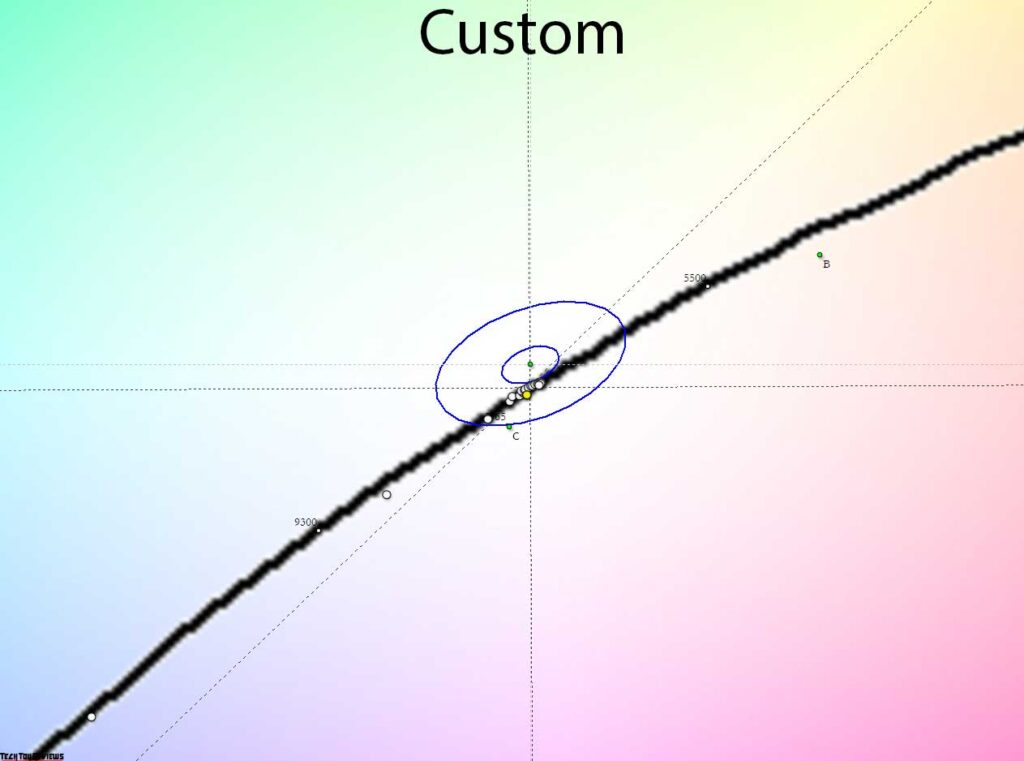
Almost the same story is observed in the Custom mode, except for a slightly different location of the gray wedge points, which have shifted by their main mass to the DeltaE<10 regions.
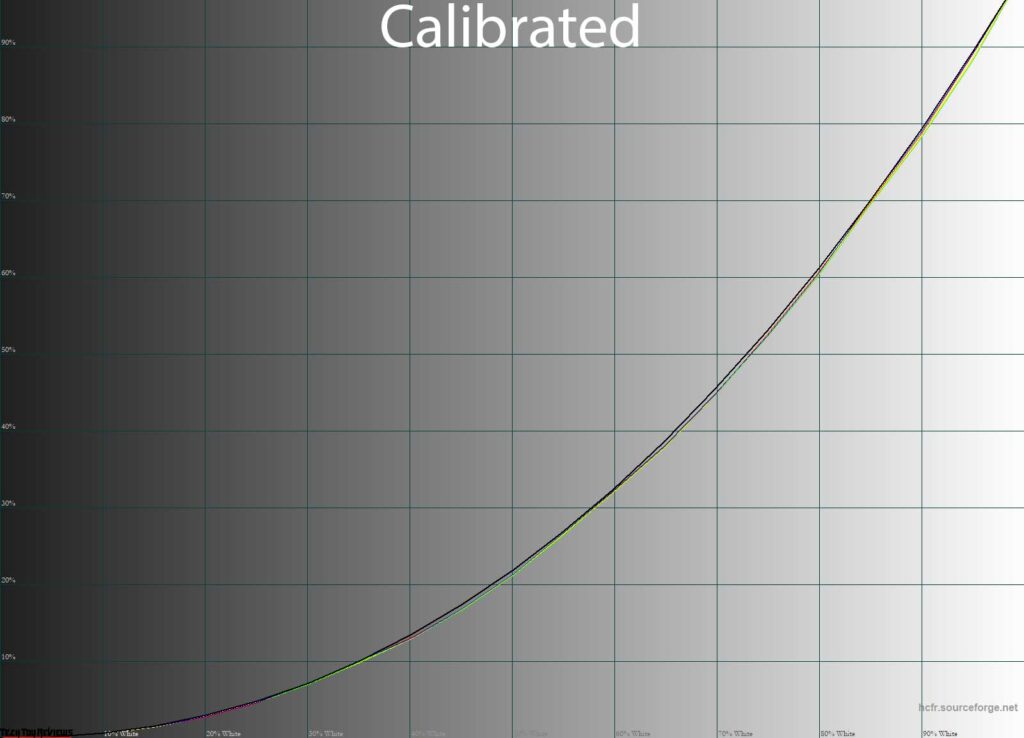
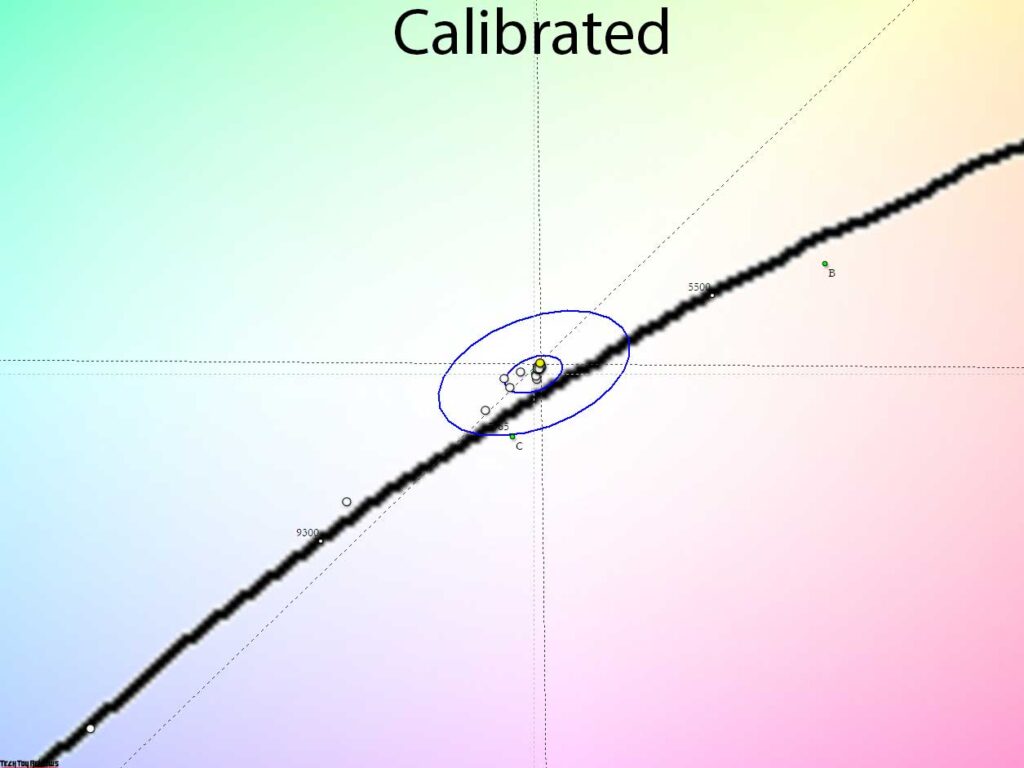
To bring the color reproduction back to normal and give the system all the necessary information about the capabilities of the display, calibration together with the creation of an individual color profile allowed. Gamma curves and the gray balance returned to normal, DeltaE94 deviations decreased to the required level. You can safely work with color and not know the problems.
Gradient uniformity
The 10-bit (8-bit + FRC) IPS panel installed in the Dell P3222QE monitor has been able to demonstrate high-quality gradients, both at default settings and after making manual edits. Of course, a large diagonal affects the visibility of transitions, but still, few people can upset such a result.


After calibration with relatively minor changes in the LUT of the video card, the gradients suffered noticeably. A fairly large number of sharp transitions appeared in the 10-50% region with obvious spurious hues (green, purple). Using FRC at its finest! Or maybe the matrix does work on the principle of 6 bits + HiFRC, due to which pseudo 10 bits become available – yes, such technologies are also available to manufacturers!
Color temperature stability
Let’s continue our Dell P3222QE review by evaluating the stability of the color temperature in standard and special picture modes.
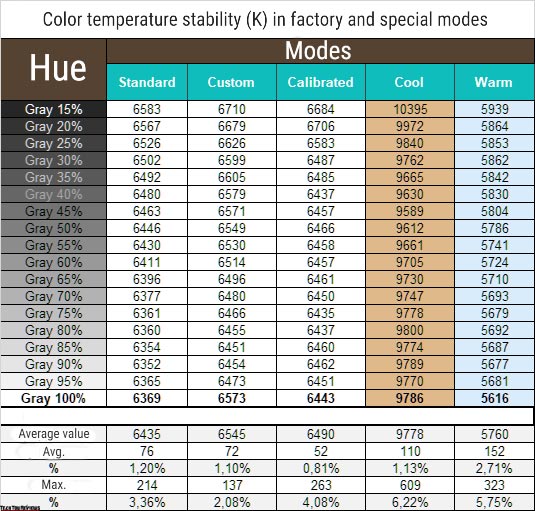
The results of this table are the deviations of the points of the gray wedge along the X-axis. They do not affect the vertical axis, and therefore it is possible to assess the presence of spurious shades only by the CIE diagram from the “Gamma curves and gray balance” subsection.
The level of color temperature stability at standard settings turned out to be quite high, and when switching to Custom with large deviations, the white point only increased: the deviations decreased to 1.1 and 2.1%, respectively. The separate “warm” mode Warm proved to be the worst of all, but Cool, despite the sharp increase in color temperature, turned out to be poor only in terms of the maximum deviation of 6.22% found in the darkest measured area. For the post-calibration version, we were able to reduce the mean deviation, but the maximum, with the default settings in it, flew almost twice that of what was achieved in the Custom.
The results are as follows: you should forget about additional factory DH modes (unless, of course, you have very specific lighting or a special passion for a “warm” or “cold” picture) and prefer the Standard mode, in which the level of DH stability is high, and DeltaE deviations are the accuracy of the white settings is minimal. If it is possible to adjust the RGB in an optimal way using the appropriate measuring devices, then this should be done first of all, and the Custom mode will help you with this (and only it).
Contrast stability and brightness range
To study the stability of the contrast and the extent of the brightness change, the Standard mode was set to begin with. The brightness value changed from 100 to 0% in increments of 10 units. For the table below, the measured value was obtained through the HCFR program, which makes it possible to more accurately estimate the black level (three decimal places) and determine a reliable contrast ratio accordingly.
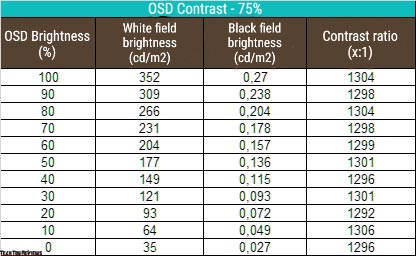
The resulting operating brightness range at standard settings was 35-352 nits with a contrast ratio of ~1300:1 on average. The decrease in brightness is linear only in the range of 70-0%, the contrast ratio is stable and higher than stated in TX by 30%.
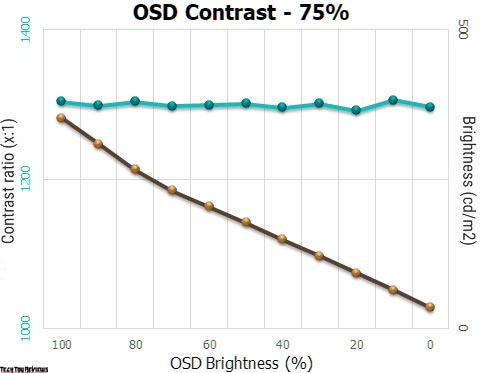
With the value of the upper limit of the white point brightness of 352 nits, the monitor was able to reach and even slightly exceed the declared TX, and given its semi-matte working surface, this will allow you to work in fairly bright external conditions. The monitor has no problems with minimum brightness either – thanks to 35 nits, the monitor will greatly reduce eye strain when working at a low level of ambient light or night – in its complete absence. Everything is in order here, let’s move on.
Response time
The Dell P3222QE claims a panel with a response time of 5-8 ms (depending on the matrix overclocking mode), measured using the Gray-to-Gray method. The default value is Response Time – Normal. There is a second possible option – Fast. Let’s compare them with each other:

At 60Hz, the Dell P3222QE is no surprise for panel speed, especially if you have experience with modern high-speed solutions. For its class, everything is in order, but it could be a little better (but maybe we’re just finding fault). At the default settings with OD Normal, the trails are small (for this segment), but with minimal artifacts, which are greatly enhanced when the Fast mode is activated, and therefore there is no practical point in turning it on.
Dell engineers decided to stop at the standard vertical frequency of 60 Hz (which is normal for a simple working 4K display), and the P3222QE has no problems at this level – there is no frame drop.
Viewing angles
As a rule, there are no questions about the viewing angles of a large 4K monitor based on IPS matrices, and the hero of the review was no exception to the rule:
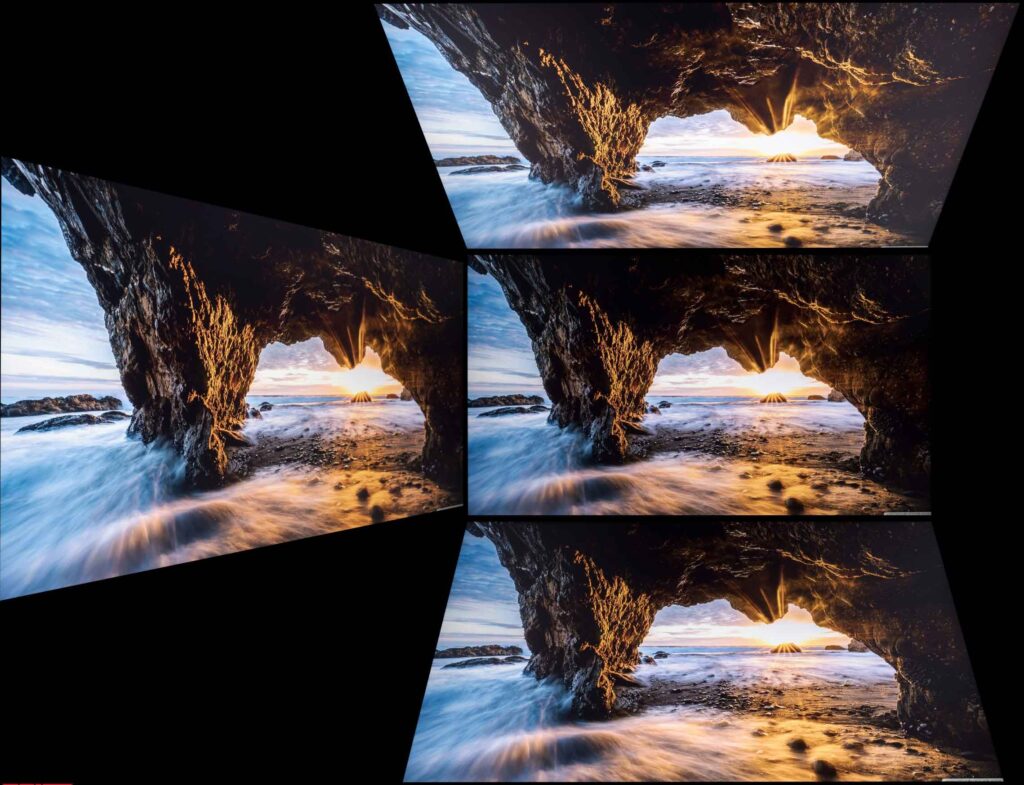
The image above shows everything perfectly. Viewing angles are at the level of other similar solutions. With slight changes in the viewing angle in the horizontal plane, the picture on the screen does not change at all. If you increase the angle to 30-45 degrees, then the image becomes less contrast, the saturation of some colors decreases, the shadows are slightly brightened. With changes in the vertical plane, the picture on the screen deteriorates much faster and stronger, especially in the area of drawing dark areas, and just the edges of the panel.
Backlight
The monitor backlight was tested at 35 points, and the brightness was set to 100 nits. All calculations (deviations) were based on data from the central point. The backlight unequal compensation system is not used in monitors, which is a common phenomenon for monitors of this price segment.
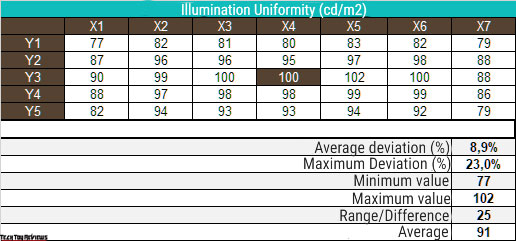
With the brightness set, the average deviation from the center point was 8.9%, and the maximum deviation was 23%, which is quite a decent result for IPS solutions with a similar diagonal.
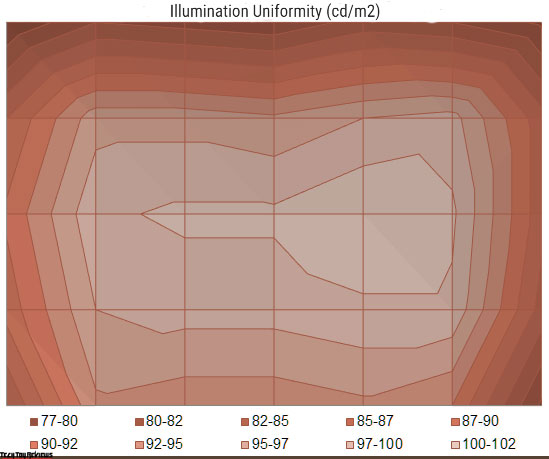
The bright and uniform zone takes up most of the space, with the left, right, and top edge of the panel being the darkest.

The photo above shows a white field with minimal corrections in a graphical editor to more visually represent what is happening on the screen in terms of bright field uniformity. In addition to darkening at the edges, some differences in color shade are also visible.




The even stronger difference in the totality of brightness and CG is visible on dark gray canvas, where all the identified features of the backlight become more obvious.
Final line
Dell continues to delight us with its new products, and the P3222QE turned out to be a great monitor for us, almost flawlessly. Its primary function is to help you solve everyday work tasks while protecting yourself as much as possible from the negative factors that affect fatigue. For this, the studied solution has everything you need: relatively high pixel density, a wide range of brightness settings, deep black for IPS (which in turn reduces the visibility of the glare effect), modified backlight spectrum A shifted blue peak in factory settings due to the use of red phosphors, almost a standard color coverage, and quite high quality.
If you are lucky, then the resulting copy may not have so many problems with uniformity on the black field (and our Dell P3222QE review unit is not so serious), and you need to be prepared for the lack of support for HDR, and adaptive synchronization systems. Some of the features we expected to see in the P3222QE – PiP/PbP and KVM. In other words, if you can afford a tested monitor, choose one with minimal backlight problems (our randomly selected sample is direct evidence of this), and about the purpose for which you’re buying it. If you are fully aware, you will definitely not be disappointed.
If you want to get something similar but with an extended color gamut up to 90-95% DCI-P3, you should pay attention to models from LG. They will have more shortcomings, the picture is certainly juicier (but not everyone needs it), but the price is immediately plus $100-200 to the cost of the Dell P3222QE. There is something to think about. Good luck making the right choice!
Dell P3222QE price and availability
The Dell P3222QE is available at $879.99 on Amazon.com, $899.99 on Bhphotovideo.com, and £488 on Amazon.co.uk online stores.
 Technology News, Reviews and Buying Guides review, monitor review, tablet review, laptop review, mobile review, smartphone review, buying guide,
Technology News, Reviews and Buying Guides review, monitor review, tablet review, laptop review, mobile review, smartphone review, buying guide,
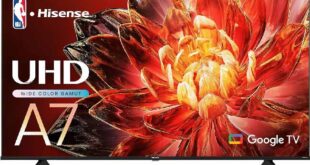
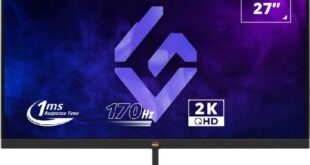

If one intends to use is as replacement for docking station – well, USB ports are fully featured, but only two are placed for easy switching and worse of all, built in Realtek USB 1Gbps Network adapter shares problems with other USB drivers and frequnetly disconnects (“no media connected”) desipte tinkering in power saving sessions.
Also – works with 521 Soundbar, but onlny through Thunderbolt, not DP/HDMI.
Otherwise – very nice display for productivity work and development.
Thank you for the information, this would be great addition to the article.
can you share the icc profiles of this review?
The panel model looks like it is LG LM315WR5-SSA1. Measurements are close to specifications